#New Renaissance Writers guild
Text
Linkty Dumpty
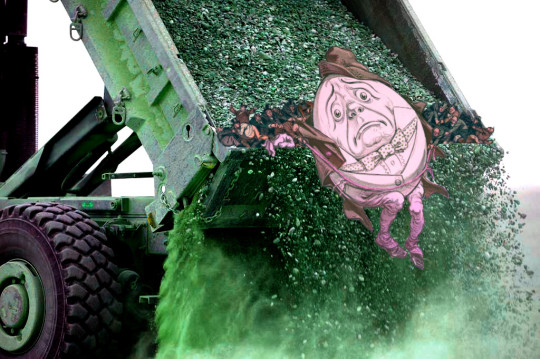
I was supposed to be on vacation, and while I didn’t do any blogging for a month, that didn’t mean that I stopped looking at my distraction rectangle and making a list of things I wanted to write about. Consequentially, the link backlog is massive, so it’s time to declare bankruptcy with another linkdump:
https://pluralistic.net/tag/linkdump/

[Image ID: John Holbo’s ‘trolley problem’ art, a repeating pattern of trolleys, tracks, people on tracks, and people standing at track switches]++
Let’s kick things off with a little graphic whimsy. You’ve doubtless seen the endless Trolley Problem memes, working from the same crude line drawings? Well, philosopher John Holbo got tired of that artwork, and he whomped up a fantastic alternative, which you can get as a poster, duvet, sticker, tee, etc:
https://www.redbubble.com/shop/ap/145078097
The trolley problem has been with us since 1967, but it’s enjoying a renaissance thanks to the insistence of “AI” weirdos that it is very relevant to our AI debate. A few years back, you could impress uninformed people by dropping the Trolley Problem into a discussion:
https://memex.craphound.com/2016/10/25/mercedes-weird-trolley-problem-announcement-continues-dumb-debate-about-self-driving-cars/
Amazingly, the “AI” debate has only gotten more tedious since the middle of the past decade. But every now and again, someone gets a stochastic parrot to do something genuinely delightful, like the Jolly Roger Telephone Company, who sell chatbots that will pretend to be tantalyzingly confused marks in order to tie up telemarketers and waste their time:
https://jollyrogertelephone.com/
Jolly Roger sells different personas: “Whitebeard” is a confused senior who keeps asking the caller’s name, drops nonsequiturs into the conversation, and can’t remember how many credit-cards he has. “Salty Sally” is a single mom with a houseful of screaming, demanding children who keep distracting her every time the con artist is on the verge of getting her to give up compromising data. “Whiskey Jack” is drunk:
https://www.wsj.com/articles/people-hire-phone-bots-to-torture-telemarketers-2dbb8457
The bots take a couple minutes to get the sense of the conversation going. During that initial lag, they have a bunch of stock responses like “there’s a bee on my arm, but keep going,” or grunts like “huh,” and “uh-huh.” The bots can keep telemarketers and scammers on the line for quite a long time. Scambaiting is an old and honorable vocation, and it’s good that it has received a massive productivity gain from automation. This is the AI Dividend I dream of.
The less-fun AI debate is the one over artists’ rights and tech. I am foresquare for the artists here, but I think that the preferred solutions (like creating a new copyright over the right to train a model with your work) will not lead to the hoped-for outcome. As with other copyright expansions — 40 years’ worth of them now — this right will be immediately transferred to the highly concentrated media sector, who will simply amend their standard, non-negotiable contracting terms to require that “training rights” be irrevocably assigned to them as a condition of working.
The real solution isn’t to treat artists as atomic individuals — LLCs with an MFA — who bargain, business-to-business, with corporations. Rather, the solutions are in collective power, like unions. You’ve probably heard about the SAG-AFTRA actors’ strike, in which creative workers are bargaining as a group to demand fair treatment in an age of generative models. SAG-AFTRA president Fran Drescher’s speech announcing the strike made me want to stand up and salute:
https://www.youtube.com/watch?v=J4SAPOX7R5M
The actors’ strike is historic: it marks the first time actors have struck since 2000, and it’s the first time actors and writers have co-struck since 1960. Of course, writers in the Writers Guild of America (West and East) have been picketing since since April, and one of their best spokespeople has been Adam Conover, a WGA board member who serves on the negotiating committee. Conover is best known for his stellar Adam Ruins Everything comedy-explainer TV show, which pioneered a technique for breaking down complex forms of corporate fuckery and making you laugh while he does it. Small wonder that he’s been so effective at conveying the strike issues while he pickets.
Writing for Jacobin, Alex N Press profiles Conover and interviews him about the strike, under the excellent headline, “Adam Pickets Everything.” Conover is characteristically funny, smart, and incisive — do read:
https://jacobin.com/2023/07/adam-conover-wga-strike
Of course, not everyone in Hollywood is striking. In late June, the DGA accepted a studio deal with an anemic 41% vote turnout:
https://www.theverge.com/2023/6/26/23773926/dga-amptp-new-deal-strike
They probably shouldn’t have. In this interview with The American Prospect’s Peter Hong, the brilliant documentary director Amy Ziering breaks down how Netflix and the other streamers have rugged documentarians in a classic enshittification ploy that lured in filmmakers, extracted everything they had, and then discarded the husks:
https://prospect.org/culture/2023-06-21-drowned-in-the-stream/
Now, the streaming cartel stands poised to all but kill off documentary filmmaking. Pressured by Wall Street to drive high returns, they’ve become ultraconservative in their editorial decisions, making programs and films that are as similar as possible to existing successes, that are unchallenging, and that are cheap. We’ve gone directly from a golden age of docs to a dark age.
In a time of monopolies, it’s tempting to form countermonopolies to keep them in check. Yesterday, I wrote about why the FTC and Lina Khan were right to try to block the Microsoft/Activision merger, and I heard from a lot of people saying this merger was the only way to check Sony’s reign of terror over video games:
https://pluralistic.net/2023/07/14/making-good-trouble/#the-peoples-champion
But replacing one monopolist with another isn’t good for anyone (except the monopolists’ shareholders). If we want audiences and workers — and society — to benefit, we have to de-monopolize the sector. Last month, I published a series with EFF about how we should save the news from Big Tech:
https://www.eff.org/deeplinks/2023/04/saving-news-big-tech
After that came out, the EU Observer asked me to write up version of it with direct reference to the EU, where there are a lot of (in my opinion, ill-conceived but well-intentioned) efforts to pry Big Tech’s boot off the news media’s face. I’m really happy with how it came out, and the header graphic is awesome:
https://euobserver.com/opinion/157187
De-monopolizing tech has become my life’s work, both because tech is foundational (tech is how we organize to fight over labor, gender and race equality, and climate justice), and because tech has all of these technical aspects, which open up new avenues for shrinking Big Tech, without waiting decades for traditional antitrust breakups to run their course (we need these too, though!).
I’ve written a book laying out a shovel-ready plan to give tech back to its users through interoperability, explaining how to make new regulations (and reform old ones), what they should say, how to enforce them, and how to detect and stop cheating. It’s called “The Internet Con: How To Seize the Means of Computation” and it’s coming from Verso Books this September:
https://www.versobooks.com/products/3035-the-internet-con

[Image ID: The cover of the Verso Books hardcover of ‘The Internet Con: How to Seize the Means of Computation]
I just got my first copy in the mail yesterday, and it’s a gorgeous little package. The timing was great, because I spent the whole week in the studio at Skyboat Media recording the audiobook — the first audiobook of mine that I’ve narrated. It was a fantastic experience, and I’ll be launching a Kickstarter to presell the DRM-free audio and ebooks as well as hardcovers, in a couple weeks.
Though I like doing these crowdfunders, I do them because I have to. Amazon’s Audible division, the monopolist that controls >90% of the audiobook market, refuses to carry my work because it is DRM-free. When you buy a DRM-free audiobook, that means that you can play it on anyone’s app, not just Amazon’s. Every audiobook you’ve ever bought from Audible will disappear the moment you decide to break up with Amazon, which means that Amazon can absolutely screw authors and audiobook publishers because they’ve taken our customers hostage.
If you are unwise enough to pursue an MBA, you will learn a term of art for this kind of market structure: it’s a “moat,” that is, an element of the market that makes it hard for new firms to enter the market and compete with you. Warren Buffett pioneered the use of this term, and now it’s all but mandatory for anyone launching a business or new product to explain where their moat will come from.
As Dan Davies writes, these “moats” aren’t really moats in the Buffett sense. With Coke and Disney, he says, a “moat” was “the fact that nobody else could make such a great product that everyone wanted.” In other words, “making a good product,” is a great moat:
https://backofmind.substack.com/p/stuck-in-the-moat
But making a good product is a lot of work and not everyone is capable of it. Instead, “moat” now just means some form of lock in. Davies counsels us to replace “moat” with:
our subscription system and proprietary interface mean that our return on capital is protected by a strong Berlin Wall, preventing our customers from getting out to a freer society and forcing them to consume our inferior products for lack of alternative.
I really like this. It pairs well with my 2020 observation that the fight over whether “IP” is a meaningful term can be settled by recognizing that IP has a precise meaning in business: “Any policy that lets me reach beyond the walls of my firm to control the conduct of my competitors, critics and customers”:
https://locusmag.com/2020/09/cory-doctorow-ip/
To see how that works in the real world, check out “The Anti-Ownership Ebook Economy,” a magisterial piece of scholarship from Sarah Lamdan, Jason M. Schultz, Michael Weinberg and Claire Woodcock:
https://www.nyuengelberg.org/outputs/the-anti-ownership-ebook-economy/
Something happened when we shifted to digital formats that created a loss of rights for readers. Pulling back the curtain on the evolution of ebooks offers some clarity to how the shift to digital left ownership behind in the analog world.
The research methodology combines both anonymous and named sources in publishing, bookselling and librarianship, as well as expert legal and economic analysis. This is an eminently readable, extremely smart, and really useful contribution to the scholarship on how “IP” (in the modern sense) has transformed books from something you own to something that you can never own.
The truth is, capitalists hate capitalism. Inevitably, the kind of person who presides over a giant corporation and wields power over millions of lives — workers, suppliers and customers — believes themselves to be uniquely and supremely qualified to be a wise dictator. For this kind of person, competition is “wasteful” and distracts them from the important business of making everyone’s life better by handing down unilateral — but wise and clever — edits. Think of Peter Thiel’s maxim, “competition is for losers.”
That’s why giant companies love to merge with each other, and buy out nascent competitors. By rolling up the power to decide how you and I and everyone else live our lives, these executives ensure that they can help us little people live the best lives possible. The traditional role of antitrust enforcement is to prevent this from happening, countering the delusions of would-be life-tenured autocrats of trade with public accountability and enforcement:
https://marker.medium.com/we-should-not-endure-a-king-dfef34628153
Of course, for 40 years, we’ve had neoliberal, Reaganomics-poisoned antitrust, where monopolies are celebrated as “efficient” and their leaders exalted as geniuses whose commercial empires are evidence of merit, not savagery. That era is, thankfully, coming to an end, and not a moment too soon.
Leading the fight is the aforementioned FTC chair Lina Khan, who is taking huge swings at even bigger mergers. But the EU is no slouch in this department: they’re challenging the Adobe/Figma merger, a $20b transaction that is obviously and solely designed to recapture customers who left Adobe because they didn’t want to struggle under its yoke any longer:
https://gizmodo.com/adobe-figma-acquisition-likely-to-face-eu-investigation-1850555562
For autocrats of trade, this is an intolerable act of disloyalty. We owe them our fealty and subservience, because they are self-evidently better at understanding what we need than we could ever be. This unwarranted self-confidence from the ordinary mediocrities who end up running giant tech companies gets them into a whole lot of hot water.
One keen observer of the mind-palaces that tech leaders trap themselves in is Anil Dash, who describes the conspiratorial, far-right turn of the most powerful men (almost all men!) in Silicon Valley in a piece called “‘VC Qanon’ and the radicalization of the tech tycoons”:
https://www.anildash.com/2023/07/07/vc-qanon/
Dash builds on an editorial he published in Feb, “The tech tycoon martyrdom charade,” which explores the sense of victimhood the most powerful, wealthiest people in the Valley project:
https://www.anildash.com/2023/02/27/tycoon-martyrdom-charade/
These dudes are prisoners of their Great Man myth, and leads them badly astray. And while all of us are prone to lapses in judgment and discernment, Dash makes the case that tech leaders are especially prone to it:
Nobody becomes a billionaire by accident. You have to have wanted that level of power, control and wealth more than you wanted anything else in your life. They all sacrifice family, relationships, stability, community, connection, and belonging in service of keeping score on a scale that actually yields no additional real-world benefits on the path from that first $100 million to the tens of billions.
This makes billionaires “a cohort that is, counterintutively, very easily manipulated.” What’s more, they’re all master manipulators, and they all hang out with each other, which means that when a conspiratorial belief takes root in one billionaire’s brain, it spreads to the rest of them like wildfire.
Then, billionaires “push each other further and further into extreme ideas because their entire careers have been predicated on the idea that they’re genius outliers who can see things others can’t, and that their wealth is a reward for that imagined merit.”
They live in privileged bubbles, which insulates them from disconfirming evidence — ironic, given how many of these bros think they are wise senators in the agora.
There are examples of billionaires’ folly all around us today, of course. Take privacy: the idea that we can — we should — we must — spy on everyone, all the time, in every way, to eke out tiny gains in ad performance is objectively batshit. And yet, wealthy people decreed this should be so, and it was, and made them far richer.
Leaked data from Microsoft’s Xandr ad-targeting database reveals how the commercial surveillance delusion led us to a bizarre and terrible place, as reported on by The Markup:
https://themarkup.org/privacy/2023/06/08/from-heavy-purchasers-of-pregnancy-tests-to-the-depression-prone-we-found-650000-ways-advertisers-label-you
The Markup’s report lets you plumb 650,000 targeting categories, searching by keyword or loading random sets, 20 at a time. Do you want to target gambling addicts, people taking depression meds or Jews? Xandr’s got you covered. What could possibly go wrong?
The Xandr files come from German security researcher Wolfie Christl from Cracked Labs. Christi is a European, and he’s working with the German digital rights group Netzpolitik to get the EU to scrutinize all the ways that Xandr is flouting EU privacy laws.
Billionaires’ big ideas lead us astray in more tangible ways, of course. Writing in The Conversation, John Quiggin asks us to take a hard look at the much ballyhooed (and expensively ballyhooed) “nuclear renaissance”:
https://theconversation.com/dutton-wants-australia-to-join-the-nuclear-renaissance-but-this-dream-has-failed-before-209584
Despite the rhetoric, nukes aren’t cheap, and they aren’t coming back. Georgia’s new nuclear power is behind schedule and over budget, but it’s still better off than South Carolina’s nukes, which were so over budget that they were abandoned in 2017. France’s nuke is a decade behind schedule. Finland’s opened this year — 14 years late. The UK’s Hinkley Point C reactor is massively behind schedule and over budget (and when it’s done, it will be owned by the French government!).
China’s nuclear success story also doesn’t hold up to scrutiny — they’ve brought 50GW of nukes online, sure, but they’re building 95–120GW of solar every year.
Solar is the clear winner here, along with other renewables, which are plummeting in cost (while nukes soar) and are accelerating in deployments (while nukes are plagued with ever-worsening delays).
This is the second nuclear renaissance — the last one, 20 years ago, was a bust, and that was before renewables got cheap, reliable and easy to manufacture and deploy. You’ll hear fairy-tales about how the early 2000s bust was caused by political headwinds, but that’s simply untrue: there were almost no anti-nuke marches then, and governments were scrambling to figure out low-carbon alternatives to fossil fuels (this was before the latest round of fossil fuel sabotage).
The current renaissance is also doomed. Yes, new reactors are smaller and safer and won’t have the problems intrinsic to all megaprojects, but designs like VOYGR have virtually no signed deals. Even if they do get built, their capacity will be dwarfed by renewables — a Gen III nuke will generate 710MW of power. Globally, we add that much solar every single day.
And solar power is cheap. Even after US subsidies, a Gen III reactor would charge A$132/MWh — current prices are as low as A$64-$114/MWh.
Nukes are getting a charm offensive because wealthy people are investing in hype as a way of reaping profits — not as a way of generating safe, cheap, reliable energy.
Here in the latest stage of capitalism, value and profit are fully decoupled. Monopolists are shifting more and more value from suppliers and customers to their shareholders every day. And when the customer is the government, the depravity knows no bounds. In Responsible Statecraft, Connor Echols describes how military contractors like Boeing are able to bill the Pentagon $52,000 for a trash can:
https://responsiblestatecraft.org/2023/06/20/the-pentagons-52000-trash-can/
Military Beltway Bandits are nothing new, of course, but they’ve gotten far more virulent since the Obama era, when Obama’s DoD demanded that the primary contractors merge to a bare handful of giant firms, in the name of “efficiency.” As David Dayen writes in his must-read 2020 book Monopolized, this opened the door to a new kind of predator:
https://pluralistic.net/2021/01/29/fractal-bullshit/#dayenu
The Obama defense rollups were quickly followed by another wave of rollups, these ones driven by Private Equity firms who cataloged which subcontractors were “sole suppliers” of components used by the big guys. These companies were all acquired by PE funds, who then lowered the price of their products, selling them below cost.
This maximized the use of those parts in weapons and aircraft sold by primary contractors like Boeing, which created a durable, long-lasting demand for fresh parts for DoD maintenance of its materiel. PE-owned suppliers hits Uncle Sucker with multi-thousand-percent markups for these parts, which have now wormed their way into every corner of the US arsenal.
Yes, this is infuriating as hell, but it’s also so grotesquely wrong that it’s impossible to defend, as we see in this hilarious clip of Rep Katie Porter grilling witnesses on US military waste:
https://www.youtube.com/watch?v=TJhf6l1nB9A
Porter pulls out the best version yet of her infamous white-board and makes her witnesses play defense ripoff Jepoardy!, providing answers to a series of indefensible practices.
It’s sure nice when our government does something for us, isn’t it? We absolutely can have nice things, and we’re about to get them. The Infrastructure Bill contains $42B in subsidies for fiber rollouts across the country, which will be given to states to spend. Ars Technica’s Jon Brodkin breaks down the state-by-state spending:
https://arstechnica.com/tech-policy/2023/06/us-allocates-42b-in-broadband-funding-find-out-how-much-your-state-will-get/
Texas will get $3.31B, California will get $1.86B, and 17 other states will get $1B or more. As the White House announcement put it, “High-speed Internet is no longer a luxury.”
To understand how radical this is, you need to know that for decades, the cable and telco sector has grabbed billions in subsidies for rural and underserved communities, and then either stole the money outright, or wasted it building copper networks that run at a fraction of a percent of fiber speeds.
This is how America — the birthplace of the internet — ended up with some of the world’s slowest, most expensive broadband, even after handing out tens of billions of dollars in subsidies. Those subsidies were gobbled up by greedy, awful phone companies — these ones must be spent wisely, on long-lasting, long-overdue fiber infrastructure.
That’s a good note to end on, but I’ve got an even better one: birds in the Netherlands are tearing apart anti-bird strips and using them to build their nests. Wonderful creatures 1, hostile architecture, 0. Nature is healing:
https://www.theguardian.com/science/2023/jul/11/crows-and-magpies-show-their-metal-by-using-anti-bird-spikes-to-build-nests

If you'd like an essay-formatted version of this thread to read or share, here's a link to it on pluralistic.net, my surveillance-free, ad-free, tracker-free blog:
https://pluralistic.net/2023/07/15/in-the-dumps/#what-vacation

Next Tues, Jul 18, I'm hosting the first Clarion Summer Write-In Series, an hour-long, free drop-in group writing and discussion session. It's in support of the Clarion SF/F writing workshop's fundraiser to offer tuition support to students:
https://mailchi.mp/theclarionfoundation/clarion-write-ins

[Image iD: A dump-truck, dumping out a load of gravel. A caricature of Humpty Dumpty clings to its lip, restrained by a group of straining, Lilliputian men.]
#pluralistic#infrastructure#broadband#linkdumps#fran drescher#labor#strikes#libraries#big tech#sag aftra#writer's strike#commercial surveillance#actor's strike#data brokers#ebooks#moats and walls#drm#licensing#glam#publishing#military privacy#copyfight#platform economics#nukes#adam conover#pentagon#birds#mergers#delightful creatures#hostile architecture
114 notes
·
View notes
Text
Fredi Washington

Fredericka Carolyn "Fredi" Washington (December 23, 1903 – June 28, 1994) was an American stage and film actress, civil rights activist, performer, and writer. Washington was of African American descent. She was one of the first Black Americans to gain recognition for film and stage work in the 1920s and 1930s. Washington was active in the Harlem Renaissance, her best known role being Peola in the 1934 film version of Imitation of Life, where she plays a young light-skinned Black woman who decides to pass as white. Her last film role was in One Mile from Heaven (1937), after which she left Hollywood and returned to New York to work in theatre and civil rights activism.
Fredi Washington was born in 1903 in Savannah, Georgia, to Robert T. Washington, a postal worker, and Harriet "Hattie" Walker Ward, a dancer. Both were of African American and European ancestry. Washington was the second of their five children. Her mother died when Fredi was 11 years old. As the oldest girl in her family, she helped raise her younger siblings, Isabel, Rosebud, and Robert, with the help of their grandmother. After their mother's death, Fredi and her sister Isabel were sent to the St. Elizabeth's Convent School for Colored Girls in Cornwells Heights, near Philadelphia, Pennsylvania.
While still in school in Philadelphia, Washington's family moved north to Harlem, New York. Washington graduated from Julia Richman High School in New York City.
Washington's entertainment career began in 1921 as a chorus girl in the Broadway musical Shuffle Along. She was hired by dancer Josephine Baker as a member of the "Happy Honeysuckles," a cabaret group. Baker became a friend and mentor to her. Washington's collaboration with Baker led to her being discovered by producer Lee Shubert. In 1926, she was recommended for a co-starring role on the Broadway stage with Paul Robeson in the play Black Boy. She quickly became a popular, featured dancer, and toured internationally with her dancing partner, Al Moiret.
Washington turned to acting in the late 1920s. Her first movie role was in Black and Tan (1929), in which she played a Cotton Club dancer who was dying. She acted in a small role in The Emperor Jones (1933) starring Robeson. In 1933, Washington married Lawrence Brown, the trombonist in Duke Ellington's jazz orchestra. That marriage ended in divorce. Washington also played Cab Calloway's love interest in the musical short Cab Calloway's Hi-De-Ho (1934).
Her best-known role was in the 1934 movie Imitation of Life. Washington played a young light-skinned Black woman who chose to pass as white to seek more opportunities in a society restricted by legal and social racial segregation. As Washington had visible European ancestry, the role was considered perfect for her, but it led to her being typecast by filmmakers. Moviegoers sometimes assumed from Washington's appearance—her blue-gray eyes, pale complexion, and light brown hair—that she might have passed in real life. In 1934, she said the role did not reflect her off-screen life, but "If I made Peola seem real enough to merit such statements, I consider such statements compliments and makes me feel I've done my job fairly well." She told reporters in 1949 that she identified as Black "...because I'm honest, firstly, and secondly, you don't have to be white to be good. I've spent most of my life trying to prove to those who think otherwise ... I am a Negro and I am proud of it."[7] Imitation of Life was nominated for an Academy Award for Best Picture, but it did not win. Years later, in 2007, Time magazine ranked it as among "The 25 Most Important Films on Race."
Washington's experiences in the film industry and theater led her to become a civil rights activist. In an effort to help other Black actors and actresses find more opportunities, in 1937 Washington co-founded the Negro Actors Guild of America, with Noble Sissle, W. C. Handy, Paul Robeson, and Ethel Waters. The organization's mission included speaking out against stereotyping and advocating for a wider range of roles. Washington served as the organization's first executive secretary. She was also heavily involved with the National Association for the Advancement of Colored People, widely known as the NAACP. While working with the NAACP, Fredi fought for more representation and better treatment of Black actors in Hollywood because she was one of the few Black actors in Hollywood who had some influence with white studio executives. Aside from working with those organizations to fight for the rights of Black actors, Washington also advocated for the federal protection of Black Americans and was a lobbyist for the Dyer Anti-Lynching Bill, which the NAACP supported.
Despite receiving critical acclaim, she was unable to find much work in the Hollywood of the 1930s and 1940s; Black actresses were expected to have dark skin, and were usually typecast as maids. Directors were concerned about casting a light-skinned Black actress in a romantic role with a white leading man; the film production code prohibited suggestions of miscegenation. Hollywood directors did not offer her any romantic roles. As one modern critic explained, Fredi Washington was "...too beautiful and not dark enough to play maids, but rather too light to act in all-Black movies..."
Washington was a theater writer, and the entertainment editor for The People's Voice (1942–1948), a newspaper for African Americans founded by Adam Clayton Powell Jr., a Baptist minister and politician in New York City who was married to her sister Isabel Washington Powell. She was outspoken about racism faced by African Americans and worked closely with Walter White, then president of the NAACP, to address pressing issues facing Black people in America.
In 1952, Washington married a Stamford dentist, Hugh Anthony Bell, and moved to Greenwich, Connecticut.
Fredi Washington Bell died, aged 90, on June 28, 1994. She died from pneumonia following a series of strokes at St. Joseph Medical Center in Stamford, Connecticut.
23 notes
·
View notes
Text

William Edmondson (c. December 1874 - February 7, 1951) was the first African American artist to have a solo show at the Museum of Modern Art, New York in 1937. He grew up near Nashville, Tennessee. Edmondson’s father, George, died when he was quite young and his mother Jane became a farm worker to support the family. He began carving tombstones and expanded his work to include sports heroes, animals, birdbaths, and figures from the Bible.
He had very little formal education and as a young man he worked for railway shops in Nashville, Chattanooga, and St. Louis. He was employed at various times as a farmhand, horse groom, orderly, fireman, and handyman. He began work as a helper for a stonemason, he discovered his talent for stone carving and built his carving tools by forging railroad spikes. In the early 1930s, he began carving tombstones for Nashville’s African American community using pieces of limestone that had been thrown away. People stopped by and bought tombstones for a few dollars. He never married.
He believed that God guided his creative endeavors and the subject matter reflected his faith. He created Martha and Mary, a sculpture based on these prominent Biblical figures. His sculpture was displayed in 1937 at his first one-person exhibition at MOMA. At the end of the exhibit, it was sold to a prominent collector. From that point, his work was recognized in national art circles.
He connected with Harlem Renaissance artist Aaron Douglas and writer James Weldon Johnson in a discussion about art and ideas. He worked as an artist on Works Progress Administration projects in Nashville (1939-41).
He had solo shows at The Montclair Art Museum The Cheekwood Fine Arts Center, The Nashville Artist Guild, and The Tennessee State Museum. His work was included in group exhibitions in DC, New York, San Francisco, and Paris. His work is in the permanent collections of The Montclair Art Museum. The University of Rochester, the San Francisco Museum of Art, and at The Hirshhorn Museum and Sculpture Garden, The National Museum of American Art, and the Smithsonian Institution. #africanhistory365 #africanexcellence
2 notes
·
View notes
Text
About me and my blog

So let me introduce myself.
I am - Dannais dde Daneann - poet, lyricist, writer, creative person, conlanger, paleolinguist, mythologist, philosopher, dreamer/romantic, traveler, clip maker, photographer, painter/illustrator, singer, vintage collector, milliner/hatter, stylist, amateur fashion model, supporter of a healthy lifestyle/nutrition and of eco-friendly old fashion, just a pretty girl (who believes that her beauty shall save the world) and many more...
I am recognized in Marquis Who's Who since 2012 as a lyrics writer. In 2012-2014 I was member of International Guild of Writers. I have printed and digital publications (of my poems/illustrations) in Almanacs and literary magazines. Also I gave few interviews to Internet News Platforms.
In childhood I lived in Great Britain (Southampton), Belgium (Louvain-la-Neuve) and France (Montpellier).
In youth I traveled nearly all over Serbia, visiting ancient and mystical places, such as Mount Rtanj, the Roman city of Felix Romuliana, the ancient fortress of Soko Grad and others.
I visited Poland (Warszawa, Lublin, Nałęczów, Kazimierz Dolny, Województwo Lubelskie, Węgorzewo, Województwo Warmińsko-Mazurskie), Hungary (Budapest, Karcag, Kisújszállás, Eger, Egeraracsa), Slovenia (Nova Gorica), Italy (Ivrea), France (Saint-Etienne-du-Gres, Beziers) and Spain (Senant, Chella, Moclin, Alhama de Granada, Castell de Ferro, Almuñecar, Alhendin, Granada, Jaen, Valle de Lecrín, Freila, Benamaurel, Torrevieja, Parque Natural Sierra de Huétor, Guejar Sierra).
For several years I lived in Poland and currently I’m living in Spain.
My favorite fashion period is all till 1980s, I dream about Italian Renaissance, 18th, 19th and early 20th century dressing, I like to dress in style of 1930-1960s, but I've had both hippie and modernized medieval/gothic/fantasy dressing experiences.
My bold fashion experiments are illustrated by photos of talented photographer (also milliner/hatter) Alexandrina Wasiliewa-Szyłowska, with whom we have Art Duet.
I want to share my fashion experiments with people, maybe inspire someone with the idea of retro and vintage fashion that is more ethical, compassionate and sustainable for the planet, and create beauty together that will save the world and make it a better place.
#vintage style#vintage#vintage photography#retro style#ecofriendly#sustainable#fashion#dresses#sustainable fashion#vintage fashion#retro fashion#vintage hat#retro outfit#retro look#retro inspired#Dannais dde Daneann#Dannais dde Danenn#Alexandrina Wasiliewa-Szyłowska#Alexandrina Wasiliewa-Szylowska#1930s#1940s#1950s#50s#1960s
1 note
·
View note
Note
Can you explain cas and the writer's strike thing?
With pleasure.
On November 5, 2007 (yes, you read the date correctly), the Writers Guild of America strike begins. Supernatural season 3 just started airing and the strike poses a bit of an issue, as at that point only the episodes up to 12th (Jus in Bello) have been written. In the original version, Sam was supposed to save Dean from going to hell by completely giving into his powers. But now there's no time to do that. There are some ideas thrown around, like ending the season/series on Mystery Spot and maybe making a film after. Eventually, four more episodes are shot and season 3 ends on 16 episodes with Dean being dragged to hell in the finale.
Now they need to do something about it. Despite the initial plans to leave the angels out of Supernatural, a decision is made to have Dean saved by one (and to make them more acceptable for Kripke, let's make them dicks that plot to start the Apocalypse). So they sign one Misha Collins for three episodes to do the job (the reason why he lowered his voice was because he'd thought he'd only be in three episodes, he openly regretted that decision later on, understandably so). Fans fall in love. So they keep him. They try to kill him off a few times, but each time the fans demand Castiel come back.
Fast forward 11 seasons and Supernatural 15x18 Despair airs on November 5, 2020. Exactly 13 years after the strike. After years of denying Destiel's existence, Castiel The Angel Of The Lord confesses his love for Dean Winchester. The internet breaks, Destiel trends above the US election and rumors about Putin's resignation. There's a new influx of fans, many of those who stopped watching are coming back. Supernatural renaissance. Nine months later Destiel hits 100k fics on AO3 as a first ship in the history of the site.
One of the most fascinating phenomena in television that started with a strike.
3K notes
·
View notes
Text
scandalous beauty: fredi washington - an analysis
“I don’t want to pass because I'm honest, firstly, and secondly, you don't have to be white to be good. I've spent most of my life trying to prove to those who think otherwise...I am a Negro and I am proud of it. ” - Fredi Washington
I just saw the movie Passing and I was reminded of some of the things that Blacks were reduced to in order to get basic respect, human dignity, and acceptance...not least of all my own Haitian grandmother. At any rate, just like the subjects in that film, early mixed-race activist and actress Fredi Washington was aware that she could have denied her African-American heritage to "pass” as white within the film industry, especially after the acclaim her performance received as tragic mulatto Peola in the original incarnation of the classic film Imitation of Life. She had light skin and green eyes. Given the levels of oppression and racism, some African-Americans with lighter skin tried hard to ‘pass’ as white to have an easier life. But after growing up in the Harlem Renaissance, Washington had been surrounded by black artists and, as a result, was fiercely proud of her heritage. In addition to her acting, Washington was also an activist. She was outspoken about racism faced by African Americans. Her experiences in the film industry and theater led her to become a civil rights activist, and she valiantly helped fight racial stereotypes of Blacks until the day she died.

Fredi Washington, according to astrotheme, was a Capricorn sun and Aquarius moon (the moon is speculative). She was born Fredericka Carolyn Washington in Savannah, Georgia, and was one of nine children of Robert T. and Harriet Walker Ward Washington. Fredi’s mother died when she was young, and she attended St. Elizabeth’s Convent in Cornwell Heights, Pennsylvania with her sister Isabel. Fredi moved to Harlem in 1919 to live with her grandmother. She left school and soon entered show business. She began her career in the early 1920s as a chorus dancer in Nobble Sissle and Eubie Blake's Shuffle Along. She adopted the stage name Edith Warren in 1926 when she acted in the lead role opposite Paul Robeson in Black Boy. Washington's stage career was interrupted when she became half of the dance team Fredi and Moiret, along with Al Moiret, and toured throughout Europe. Upon returning to the United States in 1928, her musical stage career continued with roles in Sweet Chariot (1930), Singin' the Blues (1931), and Run, Little Chillun (1933). Washington's film career began in 1929 with an appearance in Duke Ellington's short sound feature, Black and Tan Fantasy. Her best known role was that of Peola Johnson in Imitation of Life (1934). Washington's racially ambiguous look mirrored that of Peola’s, leading some to speculate that Washington, like her character in the film, passed for white during her life. Washington’s role in Imitation of Life elicited strong reactions from fans, many who saw the movie multiple times according to their declarations in her fan mail.
Unlike her character Peola, Fredi was certainly not interested in passing for white. Throughout her career, she was active in efforts to end discrimination in the film and theater industries. Her political activism began in the 1930s, when she participated in boycotts and demonstrations organized by Adam Clayton Powell, Jr., a Baptist minister and New York City politician who had married her sister Isabel. Washington also was an active writer for “The People’s Voice”, a newspaper for African Americans founded by Powell. She co-founded the Negro Actors Guild and was active in the Joint Actors Equity-Theater League Committee. Washington contributed a weekly column devoted to theater news in Powell's newspaper, The People's Voice. In a February 1944 column, Washington clearly displayed her advocacy for African American civil rights not only inside the entertainment industry but outside of it as well. When MGM was slated to do a film on the controversial book Uncle Tom’s Cabin, Washington was skeptical about whether the studio could address and portray slavery with the seriousness and sensitivity that it deserved. Washington retired from her acting career following her marriage to Lawrence Brown, a trombonist in Ellington's orchestra, in July 1933. However, her retirement lasted less than a year when she appeared with Paul Robeson in Emperor Jones later that year. Washington divorced Brown in 1948 and married Hugh Anthony Bell, a Connecticut dentist, in 1952. After her marriage to Bell, she retired permanently from show business. She died of pneumonia following a stroke in Stamford, Connecticut on June 28, 1994.
Next, I’ll cover another early pioneer of Black cinema: Pisces Canada Lee.
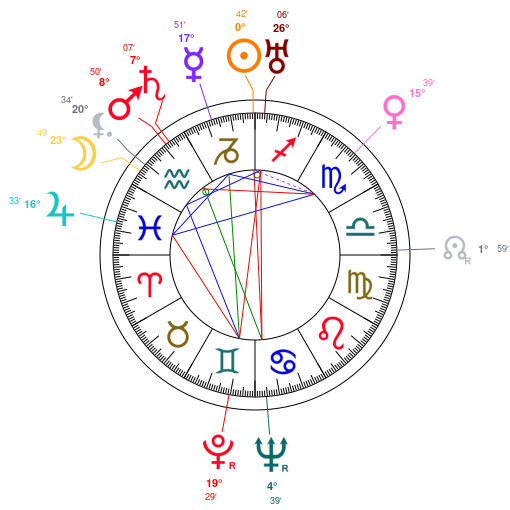
STATS
birthdate: December 23, 1903*
*note*: due to the absence of a birth time, this analysis will be even more speculative
major planets:
Sun: Capricorn
Moon: Aquarius
Rising: unknown
Mercury: Scorpio
Venus: Libra
Mars: Scorpio
Midheaven: unknown
Jupiter: Libra
Saturn: Sagittarius
Uranus: Scorpio
Neptune: Gemini
Pluto: Gemini
Overall personality snapshot: For someone who was so friendly and up-front, she was a remarkably private, self-contained and independent soul. Indeed, she might have asked herself whether she was a conventional ‘square’, masquerading in the clothes of a rebel, or a world-shaking reformer who loved to dress the elegant high-society part. One of her challenges in life was to figure out how she could reconcile her desire to rewrite the rules with her strong belief in the rule of law. When she brought these contradictory sides together, she was self-disciplined, self-motivated and a great forward-planner with good business sense, administrative skills and a detached, ethical purpose to all her activities. Her clear-headed, logical approach to any enterprise she undertook, along with her willingness to learn from her mistakes, inspired confidence and respect in friends and colleagues. She was objective and capable of confronting problems and difficulties head on, which made her a powerful ally and a formidable opponent. There was a stylish dignity and grace about her approach which, coupled with her insightful wit, made her a respected authority in her field and amongst her friends.
Both ambitious and modest, she could to get to the top of whatever mountain has caught her idealistic imagination, but never at the expense of her humanitarian ideals. Whilst she was deeply egalitarian in temperament, she knew to use her power effectively, and she thought to herself ‘someone’s got to do it’ – ‘it’ being managing things successfully from the top. Having scaled the heights, however, she could be self-effacing about her achievements. She had a strong sense of duty and moral obligation towards her fellow human beings. She wanted to make the world a better place, and was likely to have fairly clear ideas as to how this could be achieved. Her intelligence and independent mind-set did not, however, suffer fools gladly, and she resented having to work at things which curbed her beliefs and freedom of expression in any way. But she was prepared to work hard with consistent dedication for her ideals. To this end, she could be drawn to those skills and professions that made a practical difference to the world, be they in the sphere of politics, economics, academia, or in the humanities such as literature, history, psychology and counseling. In the creative arts, once she overcame her reticence about contacting and expressing her insights and emotions, she could be a profoundly poetic soul, encapsulating the essence of people and ideas in clear, elegant words, painting, dance or music.
She followed her instincts and beliefs with great dedication, but few people really knew what she was up to until after her demise. This is because she liked to keep her motivations a secret. More than likely was too brash, foul-speaking, critical and sharp-tongued at times. She knew how to make people feel at ease and instinctively knew how to resolve conflict. She was easy-going, frank and optimistic. She was quite sociable and expected other people to behave well at all times. She was eager for close personal relationships, so she tended to have a wide circle of friends. Self-indulgence could have been a problem for her, as could laziness and conceit in relationships. She was to be impatient with superficial details, preferring large-scale situations, and she disliked being tied down by obligations over which she had little control. It was often difficult for her to maintain her self-confidence and optimism, and she was easily discouraged. However, she was very intelligent. She tended to feel that there was no problem that cannot be resolved, as long as she was sufficiently informed. She could be quite cynical and fearless in his speech, but she could also be tactless. Although she was popular, periods of seclusion were necessary for her.
She always tried to make sure that she was acting for the noblest of motives, and she may have had a tendency to moralize at times. However, she had a contradictory side to her nature in that whilst she accepted challenges that stretched her, she also liked to stick with the tried and true. This made her attitudes seem erratic at times. She was part of a generation that was more honest about subjects such as death, sex and the spiritual continuity of life. As such, she wasn’t afraid to ask questions, because she wasn’t afraid of the answers she might receive. As a member of this generation, she tended to have an all or nothing personality with powerful emotions seething just below the surface. As a member of the Gemini Neptune generation, her restless mind pushed her to explore new intellectual fields. She loved communication and the occult and was likely also fascinated by metaphysical phenomena and astrology. As a Gemini Plutonian, she was mentally restless and willing to examine and change old doctrines, ideas and ways of thinking. As a member of this generation, she showed an enormous amount of mental vitality, originality and perception. Traditional customs and taboos were examined and rejected for newer and more original ways of doing things. As opportunities with education expanded, she questioned more and learned more. As a member of this generation, having more than one occupation at a time would not have been unusual to her.
Love/sex life: She was the Scorpio Martian lover least likely to acknowledge the dark side of her sexual nature. Since she was generally affable and kind, a gentle lover with a sweet approach and a courtly manner, she refused to believe that anyone could be hurt in her pursuit of pleasure but, the fact is, that they could be and often were. It’s not that she ever intended to do damage. It’s just that her emotional needs were so intense and her sexuality so overwhelming that she often ended up taking from her partners much more than they ever thought about giving. On the positive side, she was also the Scorpio Martian lover who was easiest to love. She spent less time brooding over the seriousness of sex and more time celebrating the joys of love than most lovers of this type and she was more inclined to see a relationship as a partnership rather than a power struggle. Still, she was not immune to the dark fascination with sex and the obsessive tendencies typical of this group. Her obsessions had a way of slipping up on her or of creating mischief in the background, behind her pleasant smile and lovable manner.
minor asteroids and points:
North Node: Libra
Lilith: Aquarius
Her North Node in Libra dictated dictated that she needed to move away from a tendency to see the world only in terms of herself, and develop a more outward-looking view. She needed to take other people’s needs and desires into consideration to a greater degree. Her Lilith in Aquarius ensured that she was at turns, a maverick self-creation of pure raw awesome, making others around them up their game and prickly and/or reset from being more true to their real selves. Or she could be alien to herself, straddling the line between eccentric genius or truly crazy.
elemental dominance:
air
earth
She was communicative, quick and mentally agile, and she liked to stir things up. She was likely a havoc-seeker on some level. She was oriented more toward thinking than feeling. She carried information and the seeds of ideas. Out of balance, she lived in her head and could be insensitive to the feelings of others. But at her best, she helped others form connections in all spheres of their daily lives. She was a practical, reliable woman and could provide structure and protection. She was oriented toward practical experience and thought in terms of doing rather than thinking, feeling, or imagining. Could be materialistic, unimaginative, and resistant to change. But at her best, she provided the practical resources, analysis, and leadership to make dreams come true.
modality dominance:
fixed
She liked the challenge of managing existing routines with ever more efficiency, rather than starting new enterprises or finding new ways of doing things. She likely had trouble delegating duties and had a very hard time seeing other points of view; she tried to implement the human need to create stability and order in the wake of change, ultimately, she failed.
planet dominants:
Uranus
Neptune
Saturn
She was unique and protected her individuality. She had disruptions appear in her life that brought unpleasant and unexpected surprises and she immersed herself in areas of her life in which these disruptions occurred. Change galvanized her. She was inventive, creative, and original. She was of a contemplative nature, particularly receptive to ambiances, places, and people. She gladly cultivated the art of letting go, and allowed the natural unfolding of events to construct her world. She followed her inspirations, for better or for worse. She believed in the fact that lessons in life were sometimes harsh, and structure and foundation was a great issue in her life, and she had to be taught through experience what she needed in order to grow. She paid attention to limitations she had and had to learn the rules of the game in this physical reality. She tended to have a practical, prudent outlook. She also likely held rigid beliefs.
sign dominants:
Aquarius
Capricorn
Sagittarius
She was an original thinker, often eccentric, who prized individuality and freedom above all else. Her compassion, while genuine, rose from the intellect rather than the heart. She was hard to figure out because she was so often a paradox. She was patient but impatient; a nonconformist who conformed when it suited her; rebellious but peace-loving; stubborn and yet compliant when she wanted to be. She chafed at the restrictions placed upon her by society and sought to follow her own path. She was a serious-minded person who often seemed aloof and tightly in control of her emotions and her personal domain. Even as a youngster, there was a mature air about her, as if she was born with a profound core that few outsiders ever see. She was easily impressed by outward signs of success, but was interested less in money than in the power that money represents. She was a true worker—industrious, efficient, and disciplined. Her innate common sense gave her the ability to plan ahead and to work out practical ways of approaching goals. More often than not, she succeeded at whatever she set out to do. She possessed a quiet dignity that was unmistakable. She loved her freedom and chafed at any restrictions. She sought the truth, expressed it as she saw it—and didn’t care if anyone else agreed with her. She saw the large picture of any issue and couldn’t be bothered with the mundane details. She was always outspoken and likely couldn’t understand why other people weren’t as candid. After all, what was there to hide?
Read more about her under the cut.
Fredi Washington was a pioneering African-American actress whose fair skin and green eyes often were impediments to her showing her extraordinary acting skills. Her talent was often overlooked because of people's obsession with her race and color. In the few films in which she acted her enormous talent as an actress couldn't be hidden.
Her first film performance was with Duke Ellington in a musical short, Black and Tan Fantasy (1929), as a dancer. In Hollywood she was urged to "pass" for fully white by studio heads, who said they would make her a bigger star than Norma Shearer, Joan Crawford, Constance Bennett and Greta Garbo. Fredi refused. Her best-known role was as the original Peola, in the controversial film Imitation of Life (1934). She appeared with Paul Robeson in The Emperor Jones (1933) and in a few other films with her skin darkened. Her best work was on the stage, notably in "Mamba's Daughters" with Ethel Waters. Fredi never made it to the top like her contemporaries Ethel Waters, Josephine Baker and Nina Mae McKinney because she didn't look "black" enough. But Fredi had what it took, as is more than evident in the few films that she did do.
Her best work was as an activist. She was the head of the Negro Actors Guild, helping black performers get a fair chance in the entertainment industry. Hopefully, people who discover her work today will see her beauty and talent shine through and look beyond her skin color, unlike most people of her time. (x)
18 notes
·
View notes
Text
To the TTRPG Community
Currently, across the US there are protests for the Black Lives Matter movement (there are also some protests in other countries). However, this is not enough. We need to show our support to Black people outside of them being murdered. There needs to be support for them in their hobbies and careers. It is known that some people do not feel welcome to the TTRPG community for a number of reasons. Yet, there are several that need to be recognized if you have not recognized them already. This list is incomplete and I hope it continues to grow. This list comprises of people I have found on Twitter, hence why they have their Twitter handles listed. If you have another Black person that is a part of the community but is not represented in this list, please add their name. If you are one, also add your name. Maybe you’ll find your next game you want to play, stream you want to watch, or person to follow in this list. Also please share.
Eric Lang @eric_lang on twitter. Ericmlang.com : He is a game creator that has designed over 30 games. Several of them have been on my wish list for a while.
@BGBrothas : An indie board game company that was founded and is owned by two Black creators. They have a game out on the market named RAP GODZ. One of the cofounders is Omari Akil (@OmariAkil on twitter) and they are also the host of “The Breakdown” which can be found on the Youtube channel “The Blacktop TV”.
TK Johnson (@tkjoinsthefray on Twitter): A writer that is also active in the TTRPG community. They have many published works and have been the editor on many others which you can find on their website https://www.tkjwrites.com/ some of their works include works that are available on the DM’s Guild website.
@cypheroftyr on Twitte: She is a TTRPG streamer. She is on the Rivals Waterdeep cast.
Mica Burton (@MicaBurton on Twitter and Instagram): A cosplayer and a TTRPG player. She is one of the hosts of Critical Role’s new show that aims to promote TTRPG businesses.
Krystina Arielle (@KrystinaArielle on Twitter and Krystina Arielle Tigner on Instagram): She is an actor as well as a vocal voice in the TTRPG community. She has been on many TTRPG streams. She has starred in a horror short film named “Ex Roommate” which can be found here https://www.youtube.com/watch?v=6g1kare90nE
LaTia Jacquise (@theladytiefling on Twitter): She helps run the DnD Adventurer’s League in her area. Great content if you love DnD.
Omega Jones (@CriticalBard on Twitter): I LOVE THIS MAN WITH ALL MY HEART. He makes music and loves Dungeons and Dragons. Such a kind soul. I wish the best for him. He has a twitch as well at criticalbard_.
Eric Slauson (@slausondesigns on Twitter): A game designer. He is also active on twitter.
What’s Eric Playing? (@whatseplaying on Twitter): A game reviewer! He also does playthroughs and photographs the game setups. He has a website whatsericplaying.com where he shares these photos and a list of his top 15 games.
Mandi H (@boardgamerpinup on Twitter): She is the host of “To Die For Games” which helps teach people how to play board games in a step-by-step process.
Raquel Skellington (@RaquelSkelling on Twitter): Raquel is a LARPer and graphic designer. She is also a model and her photos are GORGEOUS!
Debra Renée Byrd (@DebTheAuthor on Twitter): Debra is an author and has some works published. One of her books is Fractured Princess which is available on Amazon
Frey (@RocketCandles on Twitter): They are a dice maker who is new to the game but their dice are gorgeous.
Orion Black (@DungeonCommandr on Twitter): They are a game designer and also a Narrative Designer for WOTC. If you also would like to support nonbinary people, they are definitely someone you should support and follow. They have two games present on their website, one is a one-player TTRPG named “plot ARMOR” and another is a TTPRG named “Mutants in the Night”.
Chris Spivey (@Darker_Hue on Twitter): Chris is a game designer and a writer. He has a website for his games ( darkerhuestudios.com ). Here you will find his games, including Harlem Unbound which is a TTRPG that takes place at the height of the Harlem Renaissance and includes Lovecraftian Horror. Definitely something to check out if you love to play Call of Cthulhu.
@BGGamesWorks on Twitter: She is a writer and LARP designer.
Jonaya (@VioletRiotGames on Twitter): Jonaya is a writer and a game designer. She is also a LARPer.
B. Dave Walters (@BDaveWalters on Twitter): He is an actor on the Geek and Sundry show LA by Night and was the writer behind the Dungeons and Dragons comics A Darkened Wish.
#dnd#dungeons and dragons#critical role#cr#critrole#mica burton#ttrpg#tabletop roleplaying#tabletop role-playing game#boardgames#LARP#cosplay#WOTC#Swordsfall#Harlem Unbound#Rap Godz#Game designers#black lives matter#BLM#Support poc#support black people#support black creators#support black artists#support black voices#support black businesses#please share#krystina ariella#b. dave walters
1K notes
·
View notes
Note
You once said the Renaissance was a uniquely bad time for women. Would you mind going into moreso why? Thanks in advance.
Aha. I have indeed said this before, most recently-ish in this ask about the witch trials. I say this especially because the common (wildly erroneous) narrative of Western history goes essentially like this:
Rome good. Fall of Rome bad.
Blargle blarge Dark Ages. Bad!
Yay! Renaissance! People suddenly became smrt! (Note: by this they only ever mean the Italian Renaissance, when there were many eras of “renaissance” across the medieval world, including the Carolingian Renaissance and the Twelfth-Century Renaissance, but we don’t talk about those because Dark Ages.)
Columbus Discovered America! (tm)
Enlightenment! Yay science! Boo religion! Make Europe Smart Again!
We are now Modern. The End.
Aside from the witch trials, which were a early modern phenomenon rather than a medieval one, the cultural climate of the Renaissance involved, to put it bluntly, a lot of rich and pretentious dudebros deciding that the crises of the late medieval world had been caused by the fact that society insufficiently resembled that of Greco-Roman antiquity (which was considered to be the most perfect form of society). This involved, similarly to the backlash against women currently taking place as a result of the crises of the 21st century, attacks on the fact that medieval women enjoyed quite a bit more latitude in public life than women in antiquity ever had, and the belief that it was clearly a Bad Thing that they were now well outside those social roles. As Joan Kelly-Gadol puts it in “Did Women Have a Renaissance?”:
The Renaissance is a good case in point. Italy was well in advance of the rest of Europe from roughly 1350 to 1530 because of its early consolidation of genuine states, the mercantile and manufacturing economy that supported them and its working out of post-feudal and post-guild social relations. These developments reorganized Italian society along modern lines and opened the possibilities for the social and cultural expression for which the age is known. Yet precisely these developments affected women adversely, so much, so that there was no “renaissance” for women, at least not during the Renaissance. The state, early capitalism, and the social relations formed by them impinged on the lives of Renaissance women in different ways according to their different positions in society. But the starting fact is that women as a group, especially among the classes that dominated Italian urban elite, experienced a contraction of social and personal options that the men of their classes did not experience as markedly, as was the case with the bourgeoisie and the nobility.
I talked in this ask about how over the course of the late medieval era, women (who had heretofore been relatively present in universities and medical schools) were subject to increased and formal efforts to exclude them, under the guise of ensuring licensing requirements, standard curriculum, and individual competence. (This post also debunked some myths about premodern women’s healthcare and updated some of the arguments in that first ask.) The fact that Henry V felt it necessary to ban women from England’s universities and medical schools in 1421 demonstrates a) that they were there in the first place and b) they hadn’t been formally excluded beforehand. (This followed similar legislation in France.) Renaissance women faced sustained cultural and social pressure from this new ideal to restrict them back to “appropriate” domestic spaces. The average fertility and child-bearing rate for Renaissance women went sharply upward, especially for rich women expected to bear multiple heirs, and pregnancy and childbirth (but not necessarily child-rearing) became their overriding function. Girls began to suffer more systematically from more overt and institutionalized misogyny, both in cultural attitudes and social institutions, and it became still more of the case that daughters were regarded as less valuable than sons. These attitudes had obviously existed to some degree in the medieval era, but were refined, gained more currency and prevalence, were spread by the increasing popularity of printed literature, and began to be crystallized more explicitly.
We do have women writers of the Renaissance, Renaissance networks of intellectual exchange centered around women, and women who participated in the creation of Renaissance text and drama, whether as patrons or authors. It was sometimes the case that wealthy daughters were educated alongside sons, but dare we remark, the fact that they had recently been banned from going to university makes that a distinctly backhanded compliment; “hey, no college for you, but at least you get to learn with your brother at home!” Certain women like Margaret Roper, daughter of Sir Thomas More, were renowned for their learning, and Elizabeth I (who was obviously a princess) received an outstanding education in the Renaissance model. But nonetheless, this was a cultural sphere intensely designed by, for the needs for, and around the interests of (wealthy, educated) men, and this had both implicit and explicit misogynistic consequences. Once more from Kelly-Gadol:
In sum, a new division between personal and public life made itself fit as the state came to organize Renaissance society, and with that division the modern relation of the sexes made its appearance, even among the Renaissance nobility. Noblewomen, too, were increasingly removed from public concerns—economic, political, and cultural—and although they did not disappear into a private realm of family and domestic concerns as fully as their sisters in the patrician bourgeoisie, their loads of public power made itself fit in new constraints placed upon their personal as well as their social lives. Renaissance ideas on love and manners, more classical than medieval, and almost exclusively a male product, expressed this new subordination of women to the interests of husbands and male-dominated kin groups and served to justify the removal of women from an "unladylike" position of power and erotic independence. All the advances of Renaissance Italy, its pro-capitalist economy, its states, and its humanistic culture, worked to mold the noblewoman into an aesthetic object decorous, chaste, and doubly dependent—on her husband as well as the prince.
In other words, the Renaissance was a great time for a certain subset of elite male society, and not necessarily for everyone else. It was certainly no movement toward proto-equality, often represented an active drawback for women vis-a-vis their status in the medieval world, and laid the foundations for many of the misogynistic attitudes and assumptions that still enjoy widespread currency in the modern world. We are taught that it was some moment of “awakening” for humanity due to the deeply elite, Eurocentric, and androcentric nature of the canon of Western history, and while its ideals certainly did transform Europe at the end of the late medieval period, these were not always for the best. Once again, we can see some parallels in our own time, and while women have always served as a useful scapegoat during moments of social and economic upheaval, it would be helpful if we could at least realize how much, and what form that has taken before, even (especially) in things we are otherwise supposed to celebrate.
270 notes
·
View notes
Text
A Writer’s Plea For Bicolline
Before we get into tonight’s PSA for the writers of tumblr, we’ve all got to get on the same page. So, what is Bicolline?
https://www.bicolline.org/public/accueil/
https://www.youtube.com/watch?v=ItWgkXAl7ik&t=2s
https://www.youtube.com/watch?v=Z2CuIEEbWqs&t=1176s
That’ll be enough to give you a pretty good idea of what Bico is, but I really do encourage y’all to do your research.
So, now that that’s out of the way; welcome to why I think writers, specifically medieval and fantasy writers, should go.

1. The “Write What You Know” Conundrum
Nearly every writer has run into this piece of advice -- for better or for worse. Though coming from a genuine place, it can be frustrating for us writers who set our scenes in places we’ve never been, with events we’ve never experienced. No amount of Wikipedia pages and trips to the library will teach you exactly what facing down an army on the battlefield feels like, or the atmosphere of a tavern stuffed with sword-bearing strangers. What does the weight of armor feel like on your shoulders? How would someone react to seeing magic after seeing it for the first time? Not just people in general, either -- your character specifically.
Bicolline gives you the chance to get the closest approximation of what all this and more is actually like -- well, without all the dysentery and death. While you can get a close approximation otherwise, and that’s perfectly fine, Bicolline provides a chance to go above and beyond. After a trip to Bicolline, you could weave in sensations and experiences you would otherwise never be able to truly capture in your story.

2. The Secret of Bicolline
So why not any other live-action roleplay or renaissance fair? Well, for a few reasons:
9/10 times, you get one or the other; Bico offers a unique middle ground that allows you to roleplay when you’re comfortable, and just enjoy yourself and see the sights when you’re not.
Bicolline is just big enough and just niche enough to assure you that there is an extremely low chance of you seeing anyone you know (that you did not specifically invite to be there), especially if you live outside of Canada. If descending into the ninth ring of nerd hell, LARP, sounds interesting to you -- but you’re still on the fence -- it may ease your mind to know that your position as an arch-nerd can be closeted.
But besides this, Bicolline has achieved the writer’s holy grail. Bico, and its world Mundis, have conjured a story so beloved and so gripping that literal thousands of people cross oceans and borders just to be apart of it -- even with the knowledge that they might not make that big of a mark. Can you imagine having a fanbase with even a sliver of that passion? I, for one, want to find out what parts of Bicolline -- specifically, its story -- conjures this incredible effect on people.

3. Bicolline needs YOU
One of the most baffling things about Bicolline slowly occurred to me while I was researching it. For how incredible the event is, it’s largely unheard of to most people; this is in large due to the language barrier and more so how niche of a hobby you have to be in to get so excited for it. This is a week-long recreation of the medieval ages with a 3000 person battle and lore so deep you could take a class studying it -- no matter what reason, it seems almost impossible that this place has largely gone under the world’s radar.
Researching it, you’ll almost absolutely run into the same hurdles I did, if you don’t speak French; you can get your hands on just enough info to go, but god forbid you want a shred of lore before going. The story of Mundis is concealed in an array of documents inscribed solely in French, and the website-game that has all of the information organized so neatly is not only also in french but requires you to email Bicolline staff to get a login.
It’s largely accepted that if you’re new, you learn about Bicolline’s world by going to Bicolline. Everything from joining guilds to learning what king you’re fighting for is spread through word of mouth, as far as I've seen. While some can argue this adds to the experience, it feels almost criminal to hide away this legendary pantheon of stories behind so many boundaries. This, I think, is where we can come in.
We’re writers! Scribes! Stories run through our blood! Who better to show the world the vibrant tapestry of happenings that go on in this place but us? With our combined efforts, we could make this beautiful thing accessible to so many more people. Not only that, but if just going around, listening to stories and recording them doesn’t sound fun to you, keep in mind you can play your own character in the process -- you can write the story of your character traversing, learning about, and making their dent in this vast world.
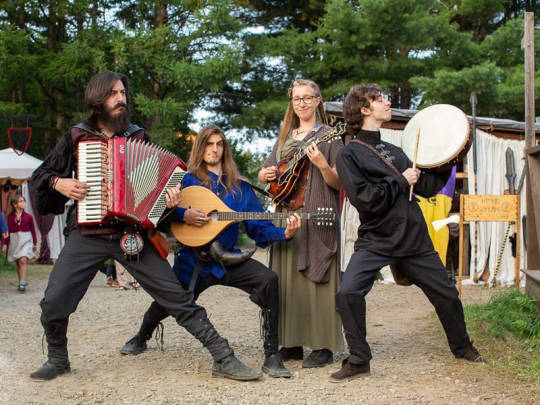
4. Have I Convinced You? Then One More Thing.
The story of Bicolline is not written by individuals, however; it’s written by groups, largely guilds. It’s part of Bicolline’s magic; the sense of community is incredibly vibrant. From my last point, however, you may be thinking -- “You just told me I could make my mark, but now you’re saying I can’t? What do you mean?”
I'm saying it’s generally difficult to do it alone. If you want to carve your name into Bicolline, you’re going to need friends at your back. Though you’re more than welcome -- no, encouraged -- to find a guild and hop on their wagon, I’d like to propose something. It’s a big If; something that could only truly come into fruition depending on how many people we can get this idea out to.
A writer’s guild; a special place for those heading to Bicolline with a passion for storytelling. What’s our purpose? Where did we come from? What're our colors -- our call to arms? Well, we’re writers, aren’t be? We can make the guild itself a communally-written story -- a sort of passion project for the Bico-enthusiasts of the writing world.
If this guild were to happen, I can only really see it be something that takes form over time. Like I said, Bicolline lore travels largely by word of mouth, so to even begin thinking about the story or goal we’d have, we’d need to go there first. We can plan our characters together, meetup at Bicolline, and develop them and our plans for this possible guild once we’ve gathered enough information.
Depending on how many people are interested in such a plan, we could possibly work together to help people who want to come but don’t have the funds -- maybe put together a GoFundMe for donations in exchange for novels/short stories of our Bico experiences. (Take a look at this; it goes to show how interesting Bicolline stories can be https://www.youtube.com/watch?v=16lF1lwgi68&list=PLKerqeWosPh4fIb7tohK56NsJJJuQp7iV&index=14) It’s a wild thought, but it’s an idea to chew on; sporadic ideas are the spice of life.

If you have any questions, let me know!
I put together a discord for anyone looking to get involved: Join Here!
Thank you for reading!! Reblogs appreciated!
#writers#writeblr#Fantasy Writing#fantasy writeblr#medieval#medieval writing#medieval writeblr#writing
7 notes
·
View notes
Note
hey im the anon who asked about how you knew the stuff, sorry i wasn't too clear on what. i just read the post explaining EPs and how the behind the scene stuff worked and i wanted to know how you knew all that, like are you involved in the industry? or just a nerd?
gotcha! Well, remember how back in S1/S2, people kept pointing out Hunk could be… awfully nosy? always getting into things, asking questions?
I was over here going, YES HUNK IS MY PEOPLE.
It’s a hallmark of a certain type of engineer: insatiable curiosity, and never satisfied with only one answer, always sure there’s more to discover. Okay, we’re not all engineers — a lot of us are Russian Lit majors — but the key is our drive to discover. We take apart, put back together, connect dots close and far, turn things around and study them from a new direction. We’re those people who randomly show up in your part of the building, poke our heads in the room and say, “so, what do all y’all do here? what’s this do? hey, what’s that?”
Despite the fact that most of us seem to be (strangely) strong introverts, that doesn’t stop us. We’ve got questions for everyone. We’ll talk to total strangers all day if we’re on the trail of a particularly interesting idea. In a nutshell, we’re utterly shameless.
I did post-production back when NLE was relatively new and the compositing applications required massive nearly-mainframe computing power. I was mostly in the sfx/cg areas, but I weaseled my way into the color suite pretty regularly. I sat in on editing sessions and was a happy lunch-fetching lackey if it got me a chance to watch the compositing team. Any lull meant a chance to chat up directors, cinematographers, producers, etc. I totally took advantage.
It’s been awhile since I did that – and since then I’ve been a roady, a mental health & substance abuse admin, a doorman, and even owned a bookstore, before going corporate. But for every wacky thing I’ve done, I’ve also kept in touch with people I met. Frex: the friend who got me the post-production job is now an executive producer. Yes, I do call him with questions. He’s used to it. If he doesn’t know an answer, he sends me to someone who does. (Another reason we’ve been friends for so long.) One answer is never sufficient, never a reason to stop there.
Meet one novelist, get introduced to six more, and three of them write for TV. Oh, that’s handy. Should save that contact, could be useful someday. It’s actually rare for someone to say no, come to think of it. idk, as long as I can get access, I can usually get the person to tell me something I can use.
However, since my actual area of expertise applies across many industries, I’ve worked all kinds of places. A lot of it’s client-facing, and if you think that means I’m not wandering around the client site poking my head into rooms and cheerfully interviewing people on the spot, then you haven’t been paying attention.
Now that I work at a multinational corporation, I have literally thousands of people in my network, including everyone who’s moved on to a new place. You might be surprised how many people are fine with, “hey, I work at X with Y, and Y told me you’d know this.” Of course, everyone has a bias and a view limited to their own experience, so you can’t stop there. You can’t really understand a situation without knowing the agendas of all the players. You gotta ask a bunch of people, make sure you’re getting the most rounded sense of things.
Not really a hardship for me. It’s kinda the whole point.
People are people everywhere (outside cultural quirks), and it’s rare I’m ever researching a single person (I’m not an investigative journalist, if you were wondering). Most of the time, I’m looking for the industry-based cultural expectations. As in, “given X and Y, what would someone who does A generally think is a reasonable action, in this situation?”
The key is to have a believable reason for asking, and being a writer definitely qualifies. “I’m researching for a story, and I have a character who do X. I wanted to know if it’s realistic for them to know Y. Who do you think would be the best person to ask?” I frequently cold-call, and I never ask “is there someone there,” I ask who they think is the best person. A lot of times it ends up being someone that the phone operator knows (personally or by reputation) who’s full of bizarre trivia and enjoys a chance to show it off. (Plus, it’s amazing what you can learn about a person from all the other subtle cues people are unaware they’re telling, when they’re focused on their area of expertise.)
That’s how I ended up interviewing the Director of the DEA about whether a non-US-university degree would satisfy the education requirement. His letter of introduction got me monthly lunches for awhile with the DEA director in my city. (Oh, the stories I heard.) It’s how I learned about sheep subsidies from one of the top execs at the USDA, and that there’s a single surviving Civil War widow still getting a VA pension. Going in person is even more fun. You could wind up talking to one of the very few artists in the world whose speciality is touching up pre-Renaissance books so the repairs aren’t visible. Or the art historian whose job is going through the nation’s attic and identifying century-old fakes.
I’ve talked to embassy officials from five different countries, NASA biophysicists and astrophysicists, OSHA inspectors, Nobel prize-winning economists, police detectives, celebrity chefs, environmental lawyers, arena-level sound-people, race-car drivers, potters, opera singers, patent examiners, train mechanics, fire marshals, foley artists, and club DJs. I’ve interviewed fashion photographers, farriers, puppeteers, lighting designers, Catholic bishops, bioethicists, rabbis, fighter pilots, public radio personalities, newspaper editors, chemists, club organizers, war correspondents, Episcopalian nuns (yes they exist), textile artists, prison architects, midwives, cabinetmakers, tall ship sailors, haute couture seamstresses, and civil engineers. On and on and on.
Don’t neglect official avenues, either. The Department of Labor, the International Brotherhood of Carpenters and Joiners, the Screen Writers’ Guild, the list is nearly endless — any organization, union, or federal/state dept that sets or guides policy. Everyone has a bias, so what people consider normal is sometimes… not. Or they just didn’t know (or saw no need to know, the fools) the reason for A over B. You have to check the rules, because a discrepancy between what you’re told should be done versus what people tell you is actually done… is also useful to know.
(Labor practices are definitely one of those areas, since federal labor policy is something every company must observe. It’s the law. So when a workplace seems to be violating the law, it raises a lot of interesting questions.)
And finally, of course, there’s traditional research. Textbooks written by people in an industry can be particularly interesting, especially if it’s a book meant for readers outside that industry (which usually means a lot of firsthand anecdotes to round out the gaps). Popular articles, academic essays, post-mortem white papers, TED talks, interviews. You need to do your basic homework, because there’s no waste of someone’s time quite like asking them a question that’s patently absurd once you get past common assumptions.
I once explained the plot of a popular SF show to a NASA astrophysicist, and his response was simply, “Every word you used was English, but those words in that order make absolutely no sense at all.” Kind of a dead-end, there. You can’t come at a top-level expert with intro-level questions.
Since I don’t always know who I’ll stumble over next, being an information sponge means I at least have a whole encyclopedia of analogies. If I can find common ground (cars and houses are two of the best), I can at least get a basic idea of the person’s meaning. “Oh, so it’s like when you turn the key in the ignition, and the lights don’t come on because the battery is dead?”
It’s asking the right questions, using an open and friendly approach, and having the right timing. Remember: there is no such thing as unskilled labor; there is only undervalued labor. That is, their time is also valuable, so be brief, open, and sincere. Treat every person as if they’re an authority in something, even if you haven’t figured out what that is.
The world is a massively complex place, and contains more things than are dreamt of in our philosophies, all of it waiting to be discovered.
Or, the shorter version:

btw: I don’t actually recommend going in person to the Dept of the Interior, though. You’ll get lost. Like, instantly. That place is MASSIVE.
#research#asking questions#to paraphrase bertrand russell#it's a good thing#to hang a question mark#on things you've long taken for granted
32 notes
·
View notes
Text
From Childish Gambino to ‘Atlanta’ & Everything in Between: The Rise of Creative Genius Donald Glover [WHERE ARE THEY NOW?]

Photo: Ibra Ake
Donald McKinley Glover Jr., more popularly known by his stage name Childish Gambino, or simply Donald Glover, is the very definition of a modern-day renaissance man. In the realm of entertainment and media, there is very little Glover has not tried his hand at and exceeded exceptionally well in doing so.
With an ever-growing list of accolades and awards, which must require both their own Wikipedia entry and a glorified trophy room somewhere in the artist’s house, Childish Gambino has not just left a mark on culture, but he has arguably shaped it. Set to headline both weekends of Coachella 2019 (where he will also be premiering his new film Guava Island, which co-stars Rihanna) and release his final album as Childish Gambino, we look back at the rise of Glover into one of the most important visionary minds of his generation.

Raised as a Jehovah’s Witness in Stone Mountain, Georgia, Glover’s varied artistic pursuits were no hidden secret. From being voted “Most Likely to Write for The Simpsons” in his high school yearbook to producing an independent mixtape while at The New York University Tisch School of the Arts, every moment of Glover’s young adult life was tied together by a constant connecting thread–the passion to create. On that note, we would be remised if we did not mention Glover’s short-lived time as a DJ.
First going by the name MC D and later changing it to mcDJ, we are sure that mcDJ was a hit at every New York college art party, seeing as how the one album he chose to remix in its entirety was Sufjan Stevens’ acclaimed 2005 release, Illinois. While Illin-Noise! unfortunately may not be what Glover will go down in history for, he was, at the time, already making a name for himself online.
As part of internet sketch comedy group Derrick Comedy, Glover’s knack for irreverent humor was racking up fans and views in the millions on a budding video sharing platform called YouTube. It was also around this time that he was contacted by producer David Miner, who, along with Tina Fey, became noted fans of Glover after reading a spec script he had written for The Simpsons. Guess high school yearbooks are about the closest objects we have to crystal balls. Well, sort of. Miner and Fey would not invite Glover to write for The Simpsons, but instead, in 2006, would invite him to write for and occasionally cameo on 30 Rock.
youtube
Writing for 30 Rock over the next four years, Glover would earn his first of many accolades, being presented the Writers Guild of America Award for “Best Comedy Series,” an award that Glover would take home as part of the writing staff, three years running. While the years from 2006 to 2009 would be the start of Glover’s critical acclaim, it would be that final year that would introduce him to his widest audience to date.
2009 saw the release Mystery Team, the artist’s first feature-length film, which was written by Derrick Comedy and featured Aubrey Plaza in her feature-length debut as well. However, it was another 2009 project that introduced the world at large to Donald Glover. The brainchild of Dan Harmon, who would later go on to help create Rick & Morty, Community introduced a primetime audience to Glover as jock-turned-nerd Troy Barnes. Starring in the show’s first five seasons, before departing the show in 2014, Community was, for many, the first real showcasing of Glover’s early promise as a rapper. Even if that early promise was demonstrated by Glover rapping about anthropology alongside Betty White covering Toto’s “Africa.”
youtube
Not to skirt over the viral outcry that was 2010’s #donald4spiderman, an outcry that is still felt today thanks to Glover having cameos in both 2017’s Spider-Man: Homecoming and 2018’s Spider-Man: Into the Spider-Verse, the crucial moment in defining his career as a culture-shaping artist was meeting Ludwig Göransson. A composer for the show Community, Göransson would become a close friend and collaborator of Glover, working on every one of his albums and EPs to date.
Before leaving Community in 2014, Glover would somehow find the time adopt the name Childish Gambino–a name given to him by a Wu-Tang Clan name generator–and release six mixtapes, an EP, and two studio albums, 2011’s Camp and 2013’s Because the Internet. Oh, and that’s not to mention the Comedy Central standup special, multiple festival performances, and television appearances that he squeezed in there as well. However, what is most impressive about Gambino is not the just the amount he accomplished but that with each new project, the progress he was making as an artist was palpable.

Camp was as straightforward a Childish Gambino rap album as they come–a blistering, raw, unfiltered 13-track run of one rap’s wittiest rappers. Yet, in Because the Internet, we see the first hint at the true depth of Gambino’s limitless talent. Enlisting the likes of Chance the Rapper, Jhene Aiko, and Azaelia Banks, and emanating a musical ambitiousness akin to early Kanye West, the sophomore effort would go on to earn a Grammy nomination for “Best Rap Album.” So, what does Glover, who is quickly making a name for himself as a series contender in the rap world do with his highly-anticipated follow-up album? He releases a funk album.
2016 was the year that defined Glover as more than just a talented rapper or a great comedic mind. It was the year that Gambino was spoken of in terms of lofty ideals like “critically-acclaimed artist” and “renaissance man.” For not only did he release the critically-lauded “Awaken, My Love!”, a mesmerizing fusion of psychedelic soul, funk, and R&B aesthetics, but he also created Atlanta.

While “Awaken, My Love!,”’s smash hit “Redbone” was played on repeat across the world, Glover was receiving equal praise for his comedy-drama series. The show, which is equal parts character study and an examination of Atlanta’s storied hip-hop scene, quite literally made history. Amongst the shower of awards Atlanta won, the show earned Glover an Emmy for “Outstanding Directing for a Comedy Series,” marking the first time the award was ever awarded to an African-American.
Following “Awaken, My Love!,” and the ongoing critical success of Atlanta, it was difficult to imagine Glover climbing any higher. This was an artist at the peak of his game. Then, in May of 2018, Donald Glover both hosted and starred as the musical guest on Saturday Night Live, otherwise known as the day he released “This Is America.”
youtube
The deafening damnation of America’s obsession with gun violence, appropriating viral dance trends, and a history of discrimination, wasted no time in invading the world’s collective conscience. Once again, Glover had evolved, cementing himself as not just a purveyor of culture but a shaper of it. So, in 2019, what’s next for the proclaimed renaissance man? Well, an end of sorts, apparently.
2019 is expected to mark not only Glover’s first time headlining Coachella but also mark Gambino’s final studio album and subsequent retirement of the project. But hey, try not to fret too much. If the history of Glover has taught us one thing, it is that the departure from one creative endeavor only leads to continued artistic evolution.
youtube
#where are they now#childish gambino#donald glover#rap#hip hop#this is america#coachella#soul#guava island
9 notes
·
View notes
Photo

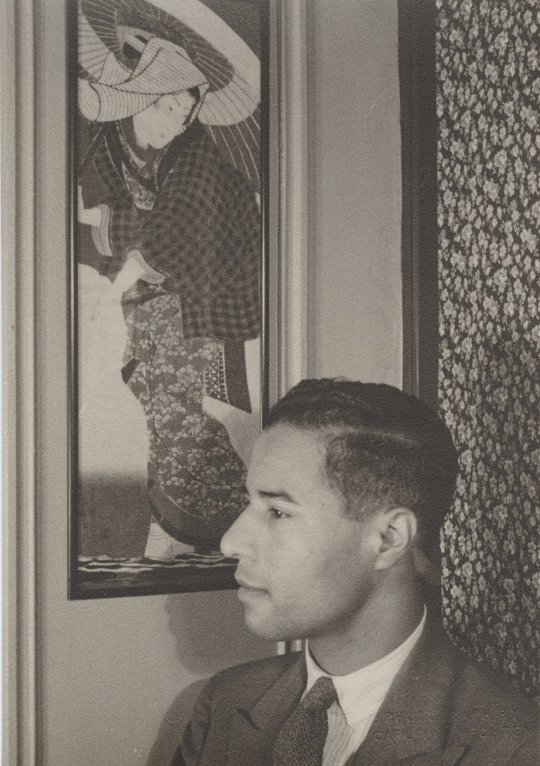


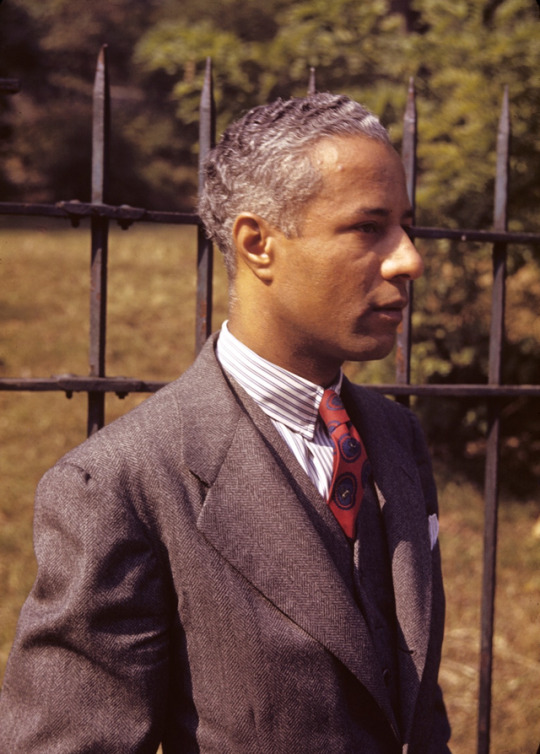
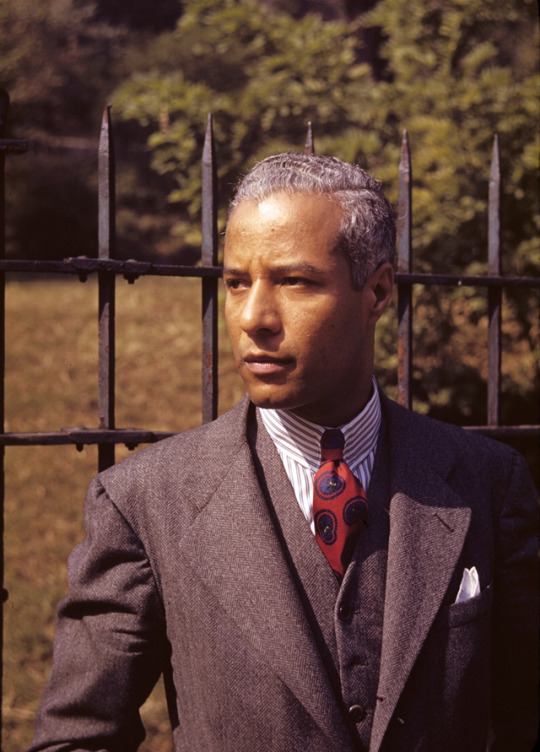
Harold Jackman photographed by Carl Van Vechten in 1932 and 1940.
Harold Jackman (1901-1961) was a teacher, model, actor, writer, and patron. Jackman was a central figure of the Harlem Renaissance. He encouraged his artistic friends and helped them make connections with those who could further their careers. His life long interest in documenting African American cultural life resulted in his recreation of what is now the Harold Jackman Countee Cullen Memorial Collection located at Robert Woodruff Library in Atlanta. Jackman was born in London to a West Indian mother and an unidentified father. He attended the prestigious DeWitt Clinton High School, a predominately white, all boys school in New York. In 1918, at school he met the man who would soon become known as Harlem’s first poet laureate, Countee Cullen. Jackman earned a B. A. from New York University and eventually received a Masters from Columbia University. He was active in many organizations like the Alpha Phi Alpha Fraternity, the Urban League and the Negro Actors Guild, where he served on the executive board. For 30 years, Jackman taught social studies in the New York public school system. He loved to travel and became sexually involved with the writer, Edouard Roditi, in France. Jackman’s diaries and collections are now considered some of the most important resources for writers and historians.
#Harold Jackman#Harlem Renaissance#african american#Black History#NYC#1940s fashion#1940s#1930s fashion#1930s#model#gay pride#lgbt#Countee Cullen#actor#writer#patron#Alpha Phi Alpha#literature#educator#teacher#vintage#vintage fashion#menswear#mens fashion#RIP#1901-1961#Edouard Roditi
1K notes
·
View notes
Text
Thoughts.
Now that the PCU has effectively been dealt with (the majority of casual role-players that I've seen have even gone so far as to include, 'feel free to message me for ERP PCU snowflakes' and 'don't interact with me if you're PCU) ... have you considered shutting down this page?
Only, and I don't mean this in a trolling-way or as a shit-post, but this page has gone from being an interesting news-feed (in my opinion) about hypocrisy to recently being a little fascist in and of itself. It almost feels like there's too much bias in the opinion of the writers here and now they're hungrily seeking-out more drama by objectifying other role-playing guilds. (The recent mention of Northern guilds 'and what they did x amount of years ago', I thought, was a bit pathetic/a bit of a shot in the dark/weak journalism.) And this' coming from someone who's never been a part of that scene.
My point is, it feels like there's some gloating going on in your posts after having effectively neutered the PCU. Imho this tumblr should now try and promote positivity on the realm and shed light on the good things happening now there's a gap in the market for new guilds (outside of the umbrella) to enter the spotlight. Like, have you guys seen what's happening in Old Town, for instance? Total renaissance of the RP there. Likewise, there's tavern-RP bustling across SW, Boralus, and even Booty Bay. No drama/toxicity to be found. It's awesome.
This' just my two cents. It's a bit difficult to read this page now because it feels like the content's getting stale and is purely one-sided. i.e. It's static. Maybe try shifting the gears and balancing out the 'tone' of the tumblr a bit more?
-----------------------------------------------
CoAD Team Response:
It very much does bring warmth to our hearts that the PCU/ACU are now effectively disbanded as an organisational group and that the good and decent people of Argent Dawn are willing to stand up and push back against them.
We however have no intention of shutting down CoAD, as you may have noticed we also focus on other increasingly non-ACU groups and individuals who have been shown to exhibit vile behaviour towards their fellow players. Though we do concede that our first and primary goal has largely been accomplished.
Guilds like many in the "Northern" community have been just as putrid as the ACU in the past, many of which have been kept on virtual life support by the likes of the Rotgarde and Grim Gest (and these days Blood of Martyrs) to serve as punching bags for the ACU.
We do not need to look far back to the Eaglecrested abusing the pronouns feature on popular RP profile mod - TRP3.
We have promoted many a good and constructive community over the years as well, namely those budding in Boralus as mentioned, and the ongoing communities Dalaran and Uldum, all of which have excellent drama-free opportunities for players to enjoy, not to mention various discord servers for players to gather and plan RP out together.
We thank you for your insight nevertheless, we have had many comments about the "tone" of our publication over the years and while we are fine with people disagreeing with how we express ourselves, very few have been able to disagree that the content on the blog ultimately helps keep the worst excesses of the server in check, with the knowledge that their sleazy activities could end up getting a front page feature on CoAD.
We will consider trying our posts in different tonal quality going forward however.
0 notes
Photo

Saint of the Day – 18 February – Blessed John of Fiesole/Fra Angelico O.P. (1387-1455) Born in 1387 in Vicchio di Mugello near Florence, Italy as Guido di Pietro – he died on 18 February 1455 in the Dominican convent in Rome, Italy of natural causes. He was known to contemporaries as Fra Giovanni da Fiesole (Brother John of Fiesole) and Fra Giovanni Angelico (Angelic Brother John). In modern Italian he is called il Beato Angelico (Blessed Angelic One); the common English name Fra Angelico means the “Angelic friar”. In 1982, Pope John Paul II proclaimed his beatification in recognition of the holiness of his life, thereby making the title of “Blessed” official. Fiesole is sometimes misinterpreted as being part of his formal name but it was merely the name of the town where he took his vows as a Dominican friar and was used by contemporaries to separate him from others who were also known as Fra Giovanni. He is listed in the Roman Martyrology as Beatus Ioannes Faesulanus, cognomento Angelicus—”Blessed Giovanni of Fiesole, surnamed ‘the Angelic’ “. Patron of Catholic Artists.

Fra Angelico was an Early Italian Renaissance painter described by Vasari in his Lives of the Artists as having “a rare and perfect talent”.
Early life, 1395–1436
Fra Angelico was born Guido di Pietro at Rupecanina in the Tuscan area of Mugello near Fiesole towards the end of the 14th century. Nothing is known of his parents. He was baptised Guido or Guidolino. The earliest recorded document concerning Fra Angelico dates from 17 October 1417 when he joined a religious confraternity or guild at the Carmine Church, still under the name of Guido di Pietro. This record reveals that he was already a painter, a fact that is subsequently confirmed by two records of payment to Guido di Pietro in January and February 1418 for work done in the church of Santo Stefano del Ponte. The first record of Angelico as a friar dates from 1423, when he is first referred to as Fra Giovanni (Friar John), following the custom of those entering one of the older religious orders of taking a new name. He was a member of the local community at Fiesole, not far from Florence, of the Dominican Order; one of the medieval Orders belonging to a category known as mendicant Orders because they generally lived not from the income of estates but from begging or donations. Fra, a contraction of frater (Latin for ‘brother’), is a conventional title for a mendicant friar.

According to Vasari, Fra Angelico initially received training as an illuminator, possibly working with his older brother Benedetto who was also a Dominican and an illuminator. The former Dominican convent of San Marco in Florence, now a state museum, holds several manuscripts that are thought to be entirely or partly by his hand. The painter Lorenzo Monaco may have contributed to his art training and the influence of the Sienese school is discernible in his work. He had several important charges in the convents he lived in but this did not limit his art, which very soon became famous. According to Vasari, the first paintings of this artist were an altarpiece and a painted screen for the Charterhouse (Carthusian monastery) of Florence; none such exist there now.
From 1408 to 1418, Fra Angelico was at the Dominican friary of Cortona, where he painted frescoes, now mostly destroyed, in the Dominican Church and may have been assistant to Gherardo Starnina or a follower of his. Between 1418 and 1436 he was at the convent of Fiesole, where he also executed a number of frescoes for the church and the Altarpiece, which was deteriorated but has since been restored. A predella of the Altarpiece remains intact and is conserved in the National Gallery, London, and is a great example of Fra Angelico’s ability. It shows Christ in Glory surrounded by more than 250 figures, including beatified Dominicans.


The Last Judgement and The Transfiguration shows the directness, simplicity and restrained palette typical of these frescoes. Located in a monk’s cell at the Convent San’ Marco and intended for private devotion.
San Marco, Florence, 1436–1445
In 1436, Fra Angelico was one of a number of the friars from Fiesole who moved to the newly built convent or friary of San Marco in Florence. This was an important move which put him in the centre of artistic activity of the region and brought about the patronage of one of the wealthiest and most powerful members of the city’s governing authority, or “Signoria” (namely Cosimo de’ Medici), who had a cell reserved for himself at the friary in order that he might retreat from the world.
It was, according to Vasari, at Cosimo’s urging that Fra Angelico set about the task of decorating the convent, including the magnificent fresco of the Chapter House, the often-reproduced Annunciation at the top of the stairs leading to the cells, the Maesta (or Coronation of the Madonna) with Saints (cell 9) and the many other devotional frescoes, of smaller format but remarkable luminous quality, depicting aspects of the Life of Christ that adorn the walls of each cell.
In 1439 Fra Angelico completed one of his most famous works, the San Marco Altarpiece at Florence. The result was unusual for its time. Images of the enthroned Madonna and Child surrounded by saints were common, but they usually depicted a setting that was clearly heaven-like, in which saints and angels hovered about as divine presences rather than people. But in this instance, the saints stand squarely within the space, grouped in a natural way as if they were able to converse about the shared experience of witnessing the Virgin in glory. Paintings such as this, known as Sacred Conversations, were to become the major commissions of Giovanni Bellini, Perugino and Raphael.

San Marco Altarpiece
The Vatican, 1445–1455
In 1445 Pope Eugene IV summoned him to Rome to paint the frescoes of the Chapel of the Holy Sacrament at St Peter’s, later demolished by Pope Paul III. Vasari claims that at this time Fra Angelico was offered the Archbishopric of Florence by Pope Nicholas V and that he refused it, recommending another friar for the position. The story seems possible and even likely. However, if Vasari’s date is correct, then the pope must have been Eugene IV and not Nicholas, who was elected Pope only on 6 March 1447. Moreover, the archbishop in 1446–1459 was the Dominican Antoninus of Florence (Antonio Pierozzi), canonised by Pope Adrian VI in 1523. In 1447 Fra Angelico was in Orvieto with his pupil, Benozzo Gozzoli, executing works for the Cathedral. Among his other pupils were Zanobi Strozzi.
From 1447 to 1449 Fra Angelico was back at the Vatican, designing the frescoes for the Niccoline Chapel for Nicholas V. The scenes from the lives of the two martyred deacons of the Early Christian Church, St Stephen and St Lawrence may have been executed wholly or in part by assistants. The small chapel, with its brightly frescoed walls and gold leaf decorations gives the impression of a jewel box. From 1449 until 1452, Fra Angelico returned to his old convent of Fiesole, where he was the Prior.
Death and beatification
In 1455, Fra Angelico died while staying at a Dominican convent in Rome, perhaps on an order to work on Pope Nicholas’ chapel. He was buried in the church of Santa Maria sopra Minerva.
When singing my praise, don’t liken my talents to those of Apelles.
Say, rather, that, in the name of Christ, I gave all I had to the poor.
The deeds that count on Earth are not the ones that count in Heaven.
I, Giovanni, am the flower of Tuscany.
— Translation of epitaph
The English writer and critic William Michael Rossetti wrote of the friar:
“From various accounts of Fra Angelico’s life, it is possible to gain some sense of why he was deserving of canonisation. He led the devout and ascetic life of a Dominican friar and never rose above that rank; he followed the dictates of the order in caring for the poor; he was always good-humoured. All of his many paintings were of divine subjects and it seems that he never altered or retouched them, perhaps from a religious conviction that, because his paintings were divinely inspired, they should retain their original form. He was wont to say that he who illustrates the acts of Christ should be with Christ. It is averred that he never handled a brush without fervent prayer and he wept when he painted a Crucifixion. The Last Judgement and the Annunciation were two of the subjects he most frequently treated.”

The Crucified Christ
Pope John Paul II beatified Fra Angelico on 3 October 1982 and in 1984 declared him patron of Catholic artists.
“Angelico was reported to say “He who does Christ’s work must stay with Christ always”. This motto earned him the epithet “Blessed Angelico” because of the perfect integrity of his life and the almost divine beauty of the images he painted, to a superlative extent those of the Blessed Virgin Mary.”— St Pope John Paul II


(via AnaStpaul – Breathing Catholic)
33 notes
·
View notes
Photo
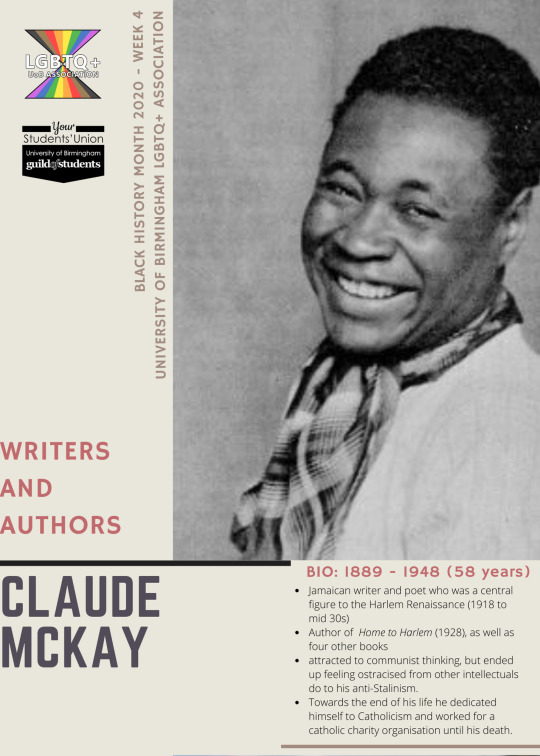


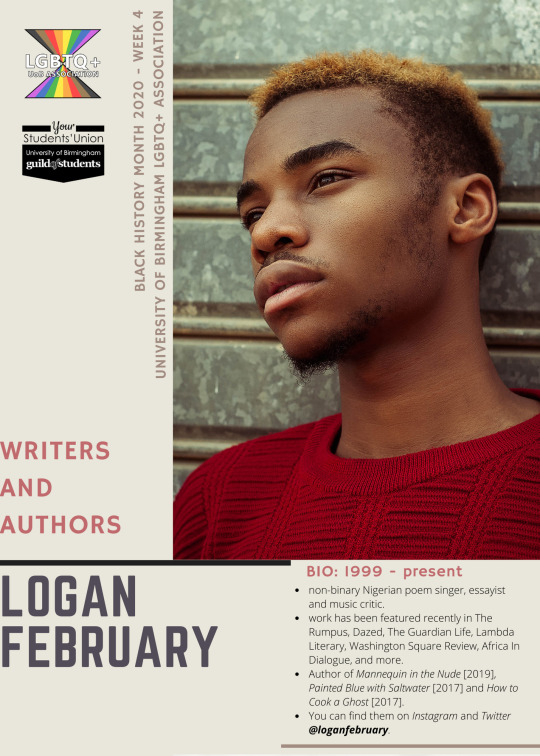
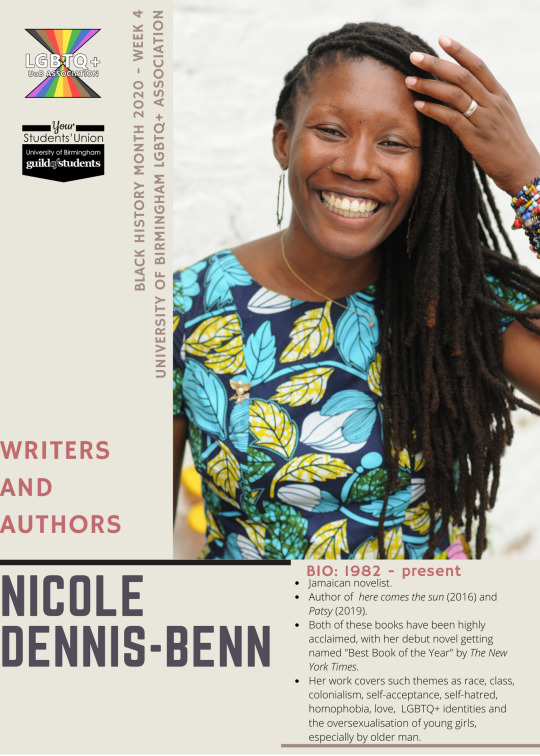
And our second post of the week, on the theme of writers, authors and journalists is up!
Today: Claude McKay, a Black poet and writer from the US; Binyavanga Wainaina, a Black Kenyan memorist and journalist; James Baldwin, a Black author and activist from the US; Logan February, a Black non binary Nigerian poet; and Nicole Dennis-Benn, a Black jamaican novelist. Claude McKay
Image Descriptions
Image 1:
A pale beige background. On the right, there’s a black and white picture of Claude McKay, a Black poet and writer. Below that, on the left is written: “Writers and Authors - TEXT”. On the right is a bullet point list reading: “Bio: 1889 - 1948 (58 years old). Jamaican writer and poet who was a central figure to the Harlem Renaissance (1918 to mid 30s). Author of Home to Harlem (1928), as well as four other books attracted to communist thinking, but ended up feeling ostracised from other intellectuals do to his anti-Stalinism. Towards the end of his life he dedicated himself to Catholicism and worked for a catholic charity organisation until his death.” In the top left, there is the LGBTQ+ Association logo, and the logo of the Guild of Students. Next to that, “Black History Month 2020 – Week 4. University of Birmingham LGBTQ+ Association” is written vertically.
/end ID
Image 2:
A pale beige background. On the right, there’s a black and white picture of Binyavanga Wainaina, a Black memorist and journalist. Below that, on the left is written: “Writers and Authors - Binyavanga Wainaina”. On the right is a bullet point list reading: “Bio: 1971 - 2019 (48 years). Kenyan memorist, short story author and journalist. He won the Caine Prize for African Writing in 2002, and in 2014 TIME magazine included him in its annual "Most Influential People in the World". Author of the memoir One Day I Will Write About This Place (2011), and the satirical essay How to Write About Africa (2005). Founding editor of the literary magazine Kwani?” In the top left, there is the LGBTQ+ Association logo, and the logo of the Guild of Students. Next to that, “Black History Month 2020 – Week 4. University of Birmingham LGBTQ+ Association” is written vertically.
/end ID
Image 3:
A pale beige background. On the right, there’s a black and white picture of James Baldwin, a Black author and activist. Below that, on the left is written: “Writers and Authors - James Baldwin”. On the right is a bullet point list reading: “Bio: 1924 - 1987 (63 years). American novelist, playwright, essayist, poet, and activist; His work contained themes of masculinity, sexuality, race, and class. Baldwin's protagonists are often, African American, and frequently gay or bisexual as well. Author of the novel Giovanni's Room (1956) and Notes of a Native Son (1955) - a collection of ten essays. Aligned himself with the ideals of the Congress of Racial Equality and the Student Nonviolent Coordinating Committee.” In the top left, there is the LGBTQ+ Association logo, and the logo of the Guild of Students. Next to that, “Black History Month 2020 – Week 4. University of Birmingham LGBTQ+ Association” is written vertically.
/end ID
Image 4:
A pale beige background. On the right, there’s a profile sideways picture of Logan February, a Black non binary Nigerian poet. Below that, on the left is written: “Writers and Authors - Logan February”. On the right is a bullet point list reading: “Bio: 1999 - present. non-binary Nigerian poem singer, essayist and music critic. work has been featured recently in The Rumpus, Dazed, The Guardian Life, Lambda Literary, Washington Square Review, Africa In Dialogue, and more. Author of Mannequin in the Nude [2019], Painted Blue with Saltwater [2017] and How to Cook a Ghost [2017]. You can find them on Instagram and Twitter @loganfebruary.” In the top left, there is the LGBTQ+ Association logo, and the logo of the Guild of Students. Next to that, “Black History Month 2020 – Week 4. University of Birmingham LGBTQ+ Association” is written vertically.
/end ID
Image 5:
A pale beige background. On the right, there’s a black and white picture of Nicole Dennis-Benn, a Black jamaican novelist. Below that, on the left is written: “Writers and Authors - Nicole Dennis-Benn”. On the right is a bullet point list reading: “Bio: 1982 - present. Jamaican novelist. Author of Here comes the sun (2016) and Patsy (2019). Both of these books have been highly acclaimed, with her debut novel getting named "Best Book of the Year" by The New York Times. Her work covers such themes as race, class, colonialism, self-acceptance, self-hatred, homophobia, love, LGBTQ+ identities and the oversexualisation of young girls, especially by older man.”
In the top left, there is the LGBTQ+ Association logo, and the logo of the Guild of Students. Next to that, “Black History Month 2020 – Week 4. University of Birmingham LGBTQ+ Association” is written vertically.
/end ID
1 note
·
View note
Text
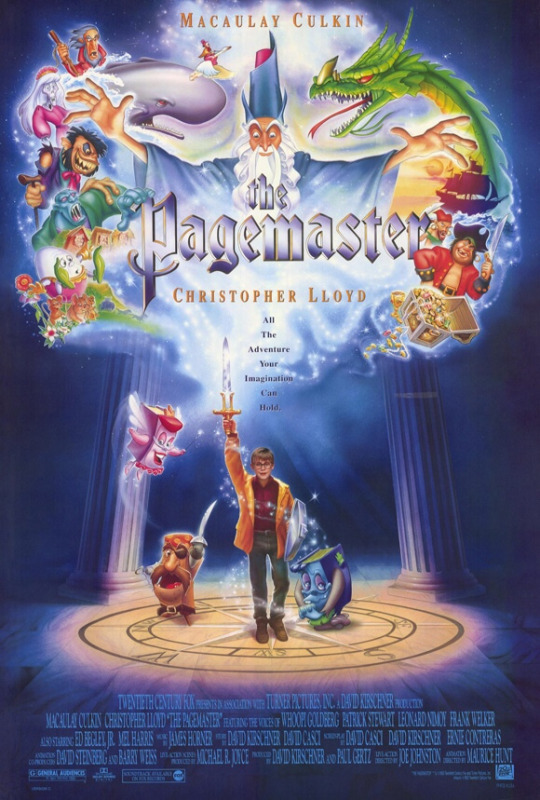
I expected this movie to have a few votes from those who remembered it as kids. I never expected it to win by a landslide. Lesson learned: never underestimate a nostalgic kids’ movie from the ’90s.
Once upon a time, David Kirschner, producer of An American Tail among other things, took his daughters to the New York Public Library. This visit inspired him to write a story about a fantastical adventure that would get kids excited about reading. The result was The Pagemaster, a 1994 box-office bomb that would go on to develop a cult following among children like me who grew up watching it. Animation historians tend to lump The Pagemaster in with the likes of Thumbelina or Quest For Camelot: 90s features that tried to coast off the success of Disney’s Renaissance films yet failed to match their caliber. But actually, trailers for The Pagemaster played in theaters and on home video a good four years before the movie was released…it was still in production for most of that time so the amount of influence Disney had on it is up for debate, but the point remains. I’m willing to bet what played a major part in its delay was the myriad of problems that cropped up during the filmmaking, from David Kirschner suing the Writers Guild of America for not receiving the sole story credit he felt was owed, to the plot being rewritten in the middle of the animation process, which is never a good thing. I’ve also heard stories about Macaulay Culkin being a diva on set, but knowing what we know now about his abusive father explains a lot so I’m not holding that against him.
And here’s another fun fact I dug up while doing my research: apparently Stephen King of all people wrote the treatment for The Pagemaster, which certainly explains the film’s more horrific elements. Does this means this movie is technically part of the King multiverse? I can see Richard hanging out with The Losers Club on weekends and trying to avoid killer clowns and langoliers in his spare time.
Though it was released under the 20th Century Fox banner, The Pagemaster was the first of only two animated films created by Turner Feature Animation, an off-shoot of Hanna-Barbera founded by media mogul Ted Turner. In hindsight, it’s not surprising that Turner had a hand in this children’s flick with an educational message. Let’s not forget the last animated project he invested himself in was all about teaching kids environmentalism in the cheesiest way possible.
youtube
But unlike Captain Planet, does The Pagemaster hold up after all these years? Will it get kids sucked into the magic of reading? And how long can I go without forcing in a Home Alone reference? Read on and find out.
The opening credits fade in over clouds swirling into foreshadowing images while the stirring main theme by James Horner plays. Say what you want about this movie, Horner’s score emerges smelling like a rose, easily the best thing to come from this film. Disney’s even used it for some of their trailers. Also, when you take the bulk of the cast into consideration, it’s astonishingly appropriate that the man who scored The Wrath of Kahn provided the soundtrack for this feature.
youtube
The ominous call-forward clouds are part of a nightmare that our protagonist, a typical 90s nerd named Richard Tyler (Macaulay Culkin) startles awake from. He crawls out of bed and overhears his parents (Ed Begley Jr. and Mel Harris) discussing their son’s neuroses. See, it’s not enough that Richard is a nerd; he’s also afraid of everything that casts a shadow. His room is plastered with safety precautions, he studies all manner of deathly statistics to the point where he can recite them at the drop of a hat and is considered a general buzzkill by all who know him, especially his father. This is where we come to our first bump in the road, and it’s not just that Richard acts in a way that no kid would, not even scaredy-cat kids like Chuckie Finster: it’s the moral they’re trying to set up.
The Pagemaster’s original screenplay was about a boy who didn’t like reading and learned to love it, but there were many rewrites during production that altered it so it’s about Richard learning to overcome his fears through the power of books. That makes the point rather redundant – why teach someone who’s already a bookworm to love books? I argue that it’s about snapping Richard out of his obsession over statistics and panic-inducing facts that are holding him back from living a fulfilling life, and finding courage and meaning from beloved stories instead. Not a terrible lesson, but one that could have been communicated better. In fact, such a moral would be much more suited for today; with the constant stream of news updates through the internet leading to anxiety over everything, turning away from devices for a while and finding solace through well-written fiction is a decent message. And I’m not saying that kids today shouldn’t be aware of big issues our planet faces – look at Greta Thunberg – but if you’re suffering from borderline pantophobia, then maybe seeking some escapism through print (and also finding a therapist) is a good place to start.
Mr. Tyler is building his son a treehouse in order to help him get over his fear of heights. Richard, of course, refuses to have anything to do with it and states some statistics about ladders and household accidents. He then unwittingly hits his dad in the head with a bucket which causes him to have an accident and fall out of the treehouse, thus proving his point. Honestly, I’d have more respect for Richard if he did it on purpose just to validate himself. What a grade-A troll he’d make.
Eager to get his son out of his hair, Mr. Tyler tasks him with picking up some nails from the hardware store. Richard takes his bike, both covered in so much superfluous safety gear that he looks like he’s ready to go policing in a sci-fi dystopia.

“I am THE LAW!”
And yes, you read that credit correctly. Joe Johnston, director of The Rocketeer and the first Captain America movie directed the live-action segments of The Pagemaster. From what I’ve gathered, he’s not too pleased to have his name attached to this project. I suppose he’s upset that he couldn’t have his credit changed to Alan Smithee.
On his way into town, Richard passes some kids riding their bikes off a construction ramp. They try to goad him into joining them and call him chicken when he doesn’t, just in case you didn’t catch what his character arc will be. Richard continues forward, and if you think Maurice’s trip to the fair went south in Beauty and the Beast, then you haven’t watched this movie. Lightning strikes the power lines, he’s forced through a tunnel where the lights explode in succession after him, and he gets lost in a dark, creepy park during a storm. I’m almost tempted to say the movie is trying to kill him.
Richard crashes his bike in front of the most ominous library outside of a Ghostbusters movie and seeks shelter there. The only person inside is eccentric old librarian Mr. Dewey, played by Christopher Lloyd. He constantly interrupts Richard to guess what kind of book he thinks he’s looking for all while getting very dramatic and dangerously close to the young boy. I laugh at it because of how over-the-top Lloyd’s acting is, but uncomfortably so. As a kid, I thought he was being very wise and passionate about the stories he looks after, but as an adult, it’s hard not to look at this scene and call stranger danger on it.
Mr. Dewey directs Richard to a phone where he can call his parents, gives him a library card if he feels like checking a book out, and casually points out the big green exit sign should he decide to leave. Richard wanders through the library until he comes across an awesome-looking mural in the rotunda depicting scenes from Moby Dick, Treasure Island, Dr. Jekyll & Mr. Hyde…umm, Dragonslayer, I guess, and a wizard who bears more than a passing resemblance to Mr. Dewey.

This is why we need more funding in our public libraries, folks.
Richard slips on the wet floor and knocks himself out. When he comes to, paint from the mural gushes to the floor, turns into a dragon-like blob and chases him through the library, turning anything it touches turns into a painted background. The blending of computer and traditional animation for the dragon is surprisingly excellent. It’s plain to see that a lot of work went into this one creature. When I can’t tell where the hand-drawn animation begins or ends, that’s a good sign.
Ultimately the dragon catches Richard and transforms him into an animated character – no, not a character, an illustration, says someone from the shadows. That someone is the master of the animated literary realm Richard’s been transported to, keeper of the books and guardian of the written word, The Pagemaster (also voiced by Lloyd).

Do you think he trims his beard by cutting it or by stitching it up and binding it with leather and glue?
This animated version of the library is where all the stories ever written call home (though Horner’s score is what really sells the wonder of the moment). Here, books are, quite literally, transports to another world. Open a book and characters, creatures and objects from that story emerge from them. The Pagemaster demonstrates this by summoning a fairytale giant and the Argo from Jason and the Argonauts just for show. Richard’s more interested in finding his way home and the Pagemaster tells him that he must pass three tests in order to reach the Exit. He sends him off on his quest with a word of advice: when in doubt, look to the books.
Richard is swept up on a book cart and crashes into his first comic relief sidekick for the evening, Adventure, a cantankerous sentient book who acts like a pirate and is played by Sir Patrick Stewart. Stewart is one of the finest actors of the stage and screen and a damn good human being (seriously, look up his speeches about domestic violence) but I’ve noticed that when it comes to animated films, he tends to skew towards the…not so good ones. Not only did he turn down roles in Beauty and the Beast and Aladdin, but for every Prince of Egypt, there’s a Chicken Little, Gnomeo and Juliet, Legends of Oz: Dorothy’s Return and Emoji Movie that proudly boasts his name. It’s mind-boggling and frustrating to hear such talent reduced to voicing shit.

Not hyperbole.
The best thing I can say about Adventure is that at least Stewart sounds like he’s having fun playing him. I should know, getting paid to talk like a pirate is the best job ever.
Adventure changes his tune when he sees Richard’s library card and offers to help the boy if he checks him out from the library. He tells Richard to go up a ladder to get their bearings, but Richard refuses on account of his acrophobia and prattles off some of those annoying statistics. Adventure tries to change his mind about climbing by opening 20,000 Leagues Under the Sea and unleashing the giant squid, which is like helping someone overcome their fear of flying by shooting them out of a cannon.
The squid throws Richard in the air but he’s rescued by another living book, Fantasy (Whoopi Goldberg). Fantasy subverts the warm fairy godmother stereotype she’s modeled after with her frequent bouts of sarcasm and stubbornness; whereas Stewart is playing a role, Whoopi is pretty much playing herself. Under normal circumstances, Fantasy would use her magic to poof Richard to the Exit, but since she’s outside of her section her powers are considerably weakened. Regardless, she also promises to help Richard if he takes her home with him. Fantasy and Adventure butt heads over who’s going to be second banana to our protagonist. Adventure insists he’s the only one who knows where they’re headed and gets Richard to open up The Hound of Baskervilles, with predictable results.

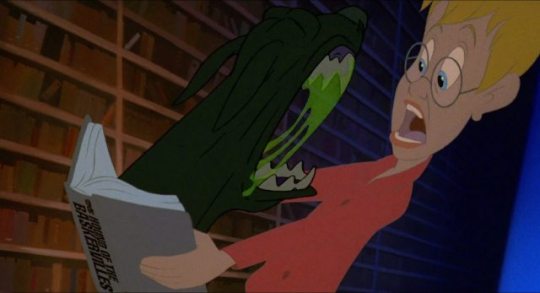
The Hound chases the trio until they jump through a bookcase into the horror section, full of spooky graveyards and assorted Halloween detritus. The Exit Sign appears through the fog but leads them to a massive and obviously haunted mansion that they must pass through in order to proceed. Richard rings the bell, which knocks the final member of the team, Horror (Frank Welker), into his arms. Horror’s my favorite of the bunch, at least he would be if I had to pick one. For one thing, with all the fairly big names in the cast, it’s refreshing to hear a veteran voice actor playing one of the lead roles. Horror’s the least like the genre he represents, a sweet dimwit who just wants some friends. I don’t know, maybe I just have a soft spot for lonely ugly-cute marshmallow characters.
Speaking of, the designs for the books aren’t exactly appealing with large faces plastered right on their spines and little arms and legs sticking out of their lumbering square bodies. Horror’s look, however, comes the closest to working since he’s modeled after Quasimodo and isn’t supposed to be Mr. Universe if you catch my drift. He even gets some moments of good wild animation, especially when he’s “describing” what frightens him.
But one line, one solitary bit of dialogue has always stuck with me: “Horror always has sad endings”. It’s a shockingly deep statement that sums up the tragedy of his situation, and also why I’ve never been that big on the genre. The monster’s dead, everyone’s safe, you think it’s all ok, then BOOM. It pops up again, slaughters every character you’ve grown to care for and sets up a neverending chain of watered-down sequels and reboots.
Fantasy assures Horror her world is a place of happy endings, and Richard allows him to come along for the ride. The group ventures into the mansion, which looks perfect as far as haunted houses go. It’s caught somewhere between traditional Gothic and German Expressionism with its impossibly high ceilings, winding staircases, cobwebbed cracks in the walls and looming shadows. The team then meets the mansion’s owner, Dr. Henry Jekyll, played by…Leonard Nimoy?!

Fascinating.
It goes without saying that Nimoy is magnetic as both Jekyll and his wicked counterpart. He encapsulates the madness and depravity of the latter with a cackle and a single line, and he plays the former with a warm air of wisdom and sophistication (the fact that he serves his Hyde potion in a martini glass should clue you in on that trait). It makes me wish we got to see Nimoy play Jekyll and Hyde in a more straightforward adaptation before he passed away.

Though maybe he already did…
Adventure is ready to help himself to some of Jekyll’s cocktail but Horror knocks it out of his hands and the spill burns a hole through the floor.
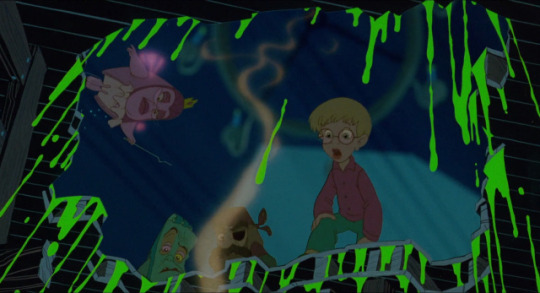
So the Hyde formula’s secret ingredient is xenomorph blood. Who knew?
Richard and the gang are too late to stop Jekyll from drinking his concoction and he undergoes a harrowing transformation into his evil alter-ego, Edward Hyde. And hoo boy, did this scene reopen a can of worms. Imagine you’re a five-year-old enjoying this fun little animated escapade of talking books and magic and then this gets all up in your face.
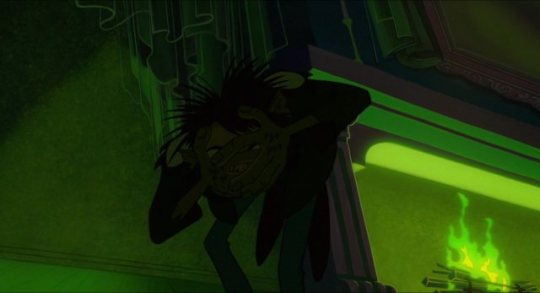
“My name…is…”

“…Mister HYYYYYYYDE!!!!!”

All this to say even after all these years, Mr. Hyde still kind of puts me on edge. I remember my dad taught me how to use the fast-forward button on the VCR just so I could rush through this part. I even wished for and made up a kind of video player where you could skip entire scenes for the sole purpose of avoiding Hyde’s reveal.

I’m still waiting on my royalties.
Hyde attacks the group but Horror accidentally saves them by dropping a chandelier on him.

Hey, wrong story!
Horror gets tangled up in the chains and is about to be pulled through the floor along with Hyde. Fantasy begs Richard to save him but he’s too scared to. He doesn’t even try to weasel out of it by saying he has bone spurs or some other lame excuse, he just stands there and shrugs as one of his friends is about to die. Our hero, ladies and gentlemen. I know Richard’s supposed to learn courage over the course of the movie but not even attempting to try is pretty low. It’s not like there’s any danger in the situation or a possibility that Hyde will pop back up again; the freak’s too busy dragging Horror down, laughing maniacally in the dark as he anticipates pulling one helpless victim to their doom along with him.

Can’t sleep, Hyde will eat me…
Anyway, Fantasy has enough and rescues Horror herself. As for Hyde, he goes down the hole never to be seen again.
youtube
Now that I’m more familiar with the stories featured in this movie more so than when it was released, seeing them come and go rather quickly without diving into their essence is disappointing…but perhaps that was intentional. Maybe by leaving these sequences fairly open-ended and giving us the most basic of recaps, the movie is encouraging kids to check out the books themselves and come to their own conclusions about how and why these are timeless, fascinating tales.
Or at the very least, they could pick up an illustrated abridged version. Try getting a six-year-old to sit through the complete Moby Dick.
You’re a prodigy, Matilda! You don’t count!
After fleeing Hyde, Richard and the gang run into some possessed books – in other words, they’re haunted by ghost stories.
youtube
They evade the spirited tomes and had things worked out differently, they would have immediately had a perilous encounter with another famous literary horror character, Frankenstein’s monster. Poor Frankie M. made it to the poster and a few promotional picture books but not the final film. It’s not clear why he was cut; maybe the director felt the sequence was running long or he got worried the kids watching this would be too scared by this point. Frankly, anything that comes after Hyde pales in comparison. You could throw the worst of Lovecraft our way and it still wouldn’t be half as terrifying as he was.
The team makes it outside, but are trapped on a high vine-covered wall. Richard is too scared to climb down until the Pagemaster possesses a gargoyle to give some on-the-nose words of encouragement.

Careful, Richard. The last time I saw a gargoyle like that, it didn’t end well for the person grabbing it.

Richard Tarzans his ways to safety, and everyone celebrates their escape. The sun rises, clearing the way to the ever-elusive Exit Sign and Adventure’s home turf, a beach stretching into the open sea. Out on the ocean, they come across the crew of the Pequod. They’re searching for the white whale Moby Dick at the behest of Captain Ahab, voiced by George Hearn.
Hmm, George Hearn playing an overly dramatic psychopath hellbent on bloody vengeance? Can’t imagine where they got that casting idea from.

Ahab spies his quarry off the port bow and the color scheme dramatically shifts into a fiery red while the mad captain’s eyes glow and he turns into a Frank Miller drawing.

Lift your spearhead high, Ahab! Hear its singing edge!
I don’t know why they went with this abrupt change in hue, but frankly my dear I don’t give a damn. It’s a visual representation of Ahab’s unhinged thirst for violence teetering on demonic possession that just looks really cool. Also, like Nimoy before him, Hearn makes the most of his screen time, giving a stirring rendition of some of Ahab’s immortal lines.
…Then Moby Dick pounces on top of him and kills him and his crew instantly.
youtube
But Moby’s not done dicking around yet and he smashes Richard’s boat too. Richard and Adventure latch on to some driftwood, but it looks like Fantasy and Horror didn’t make it and there are sharks closing in.
The good news: they’re quickly rescued.
The bad news: they’re taken prisoner aboard the Hispaniola which is under the command of Long John Silver (Jim Cummings) and his crew of cutthroat pirates.
Well, calling them cutthroat is generous. The Pirates Who Don’t Do Anything are more threatening than these guys.
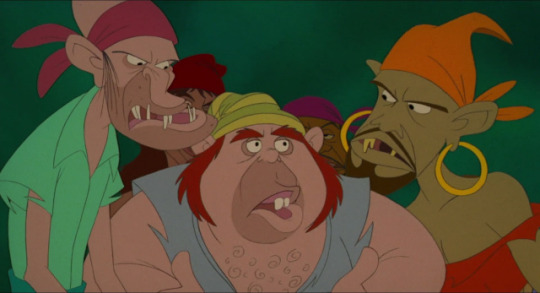
With catlike tread, upon our foe we steal!
Also, one of the pirates is voiced by Robert Picardo and…do you think David Kirschner just wanted to make one big Star Trek crossover movie but the execs shot it down so he turned it into this cute family flick starring cast members from almost every iteration of the franchise? Like, Picard and Guinan are banished to another dimension inspired by various Holodeck fantasies thanks to a resurrected omniscient Commander Kurge (just another one of Q’s little tests for humanity) and are tasked with protecting a young boy, the son of Henry Starling, who’s the key to defeating him as they find their way back home. They wind up in a desolate corner of the universe where they meet Spock, who’s been working on a top-secret formula that will supposedly make human urges easier to differentiate in important decision-making. But plot twist! It’s really Evil Spock the whole time, and his formula will purge all good from those who consume it! They escape, desperate to warn this dimension’s Federation of Evil Spock’s plan but run into an insane Dr. Berel and are later captured by The Doctor, who has rebelled from his programming and taken up piracy along with a renegade band of Romulans. I’m no Star Trek aficionado, but this is something I’d like to see!
Silver takes away Richard’s library card and forces him and Adventure to join his treasure hunt on (where else?) Treasure Island. But like in the story this is based on, the pirates are enraged to learn that the treasure has already been looted and they mutiny against Silver. Before things get ugly, Fantasy and Horror arrive to save their friends. It turns out they didn’t drown after all due to Horror discovering his hump is hollow and they floated to shore on it.
Then there’s a fight scene where Horror and Fantasy take out the pirates using goofy slapstick. It isn’t too bad, but it doesn’t touch Muppet Treasure Island in comedy. Richard also stands up to Silver and gets him to back off, which earns the old sea dog’s respect. This makes this sequence the most faithful of all the quick adaptations we’ve seen thus far, essentially turning Richard into a stand-in for Jim Hawkins and having him go through an abridged version of his arc. It would have resonated more, however, if we spent more time with the plot and characters of this story, so we’d really feel something when Richard asserts himself. The Pagemaster is a scant seventy-five minutes, but with all the possibilities for expanding upon these different novels in this format with the kind of story they’re trying to tell, this could be a ninety-minute film at the very least. The movie even teases this with some cleverly woven-in shoutouts to other famous works, like Edgar Allen Poe’s Raven appearing in the haunted house, or Richard staggering under an oversized copy of Atlas Shrugged. I wish we could see those tales as part of the plot proper, but they make this literature-based world feel more all-encompassing and less like they’re merely covering the basics, for which I’m grateful for.
Adventure, who got sidelined at the start of the fight and is miffed about missing the action, storms off on his own. This is where the movie sidelines the main plot for a substandard “jerk with a heart of gold learns not to be a jerk to others” subplot. Horror tries to cheer up Adventure and admits he idolizes him, but Adventure bullies and scares him away. Shortly after, Adventure finds Richard’s library card washed up on the beach and returns it, but Fantasy forces him to look for Horror and apologize before they hit the road. He finds him being tied down by the Lilliputians from Gulliver’s Travels. Now Gulliver’s Travels could technically be classified as an adventure story, but really it’s a witty satire in the guise of an adventure. I wonder what we could have gotten if the movie explored other stories that mashed up the genres featured here with ones like mystery or sci-fi or drama. I want to see how Sherlock Holmes, Tom Sawyer, Captain Nemo, and Lizzie Bennett would react to this kid from the future and his three sentient books running around their stories! Or what about ones where the elements of fantasy, horror, and adventure overlap each other? Think about it, A Christmas Carol is both horror and fantasy, The Princess Bride is fantasy and adventure, The Call of Cthulu, A Wrinkle in Time and anything by Neil Gaiman and Terry Pratchett combine all three. I’m sorry I keep going off on these tangents, but the concepts this film presents deserve more exploration than what we’re given.
Adventure rescues Horror and the two reconcile. Fantasy’s wand lights up, indicating that they’re getting closer to her territory and the Exit. Just to be sure she’s got her magic back, she tests it out by turning Adventure into –
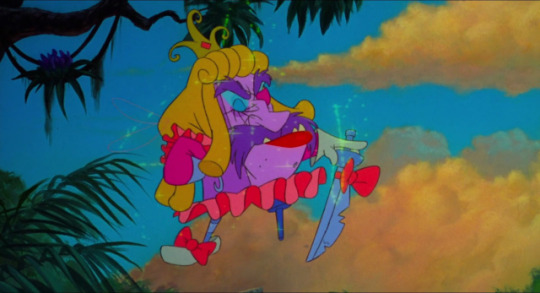
Your very confusing nightmares for the next month, ladies and gentlemen.
Everyone traipses through the jungle into the fantasy section, which goes a bit beyond your average picture book in terms of design. Though the movie’s backgrounds and colors are a bit murky, each world has a distinct visual style. The fantasy realm is like if Arthur Rackham tangoed with Eyvind Earle. It’s not Sleeping Beauty levels of gorgeousness, though it’s close. But once again, the magic of this scene comes from the music. Instead of more instrumental backing, however, we get the movie’s main tune, “Whatever You Imagine”.
youtube
I unironically love this song. I’ve said before I’m a sucker for 90s pop ballads and this one is no exception. It’s all about using the power of imagination to follow your dreams and shape the world into a better place, and is complemented by the visuals: some fairies that are rotoscoped in a way that they look like living embodiments of the electricity balls you find at Spencer’s appear and dance on Richard’s palm. There’s a second decent pop song in a similar vein over the end credits, “Dream Away” sung by Lisa Stanfield and Babyface, but “Whatever You Imagine” is my favorite of the two.
Yet, nice as this part is, it’s difficult to overlook the shortcomings. You thought the horror and adventure parts of the movie were rushed? What little we see of the fantasy section is limited to a minute and a half of the song before hurtling into the climax. On top of that, the only representations of fantasy here apart from the fairies are nursery rhymes (with Mother Goose and Humpty Dumpty making five-second cameos), generic familiar fairy tales (most of which, including Rapunzel and Cinderella, also joined Frankenstein’s Monster on the cutting room floor), a faun that looks like it was kidnapped from Fantasia, and a yellow brick road as a shout-out to The Wizard of Oz. I get this was a few years before Harry Potter revolutionized the genre, but no love for Lord of the Rings? No Peter Pan? No Narnia? No Earthsea? No Discworld? Not even Dr. Seuss? And if it’s because they’re sticking with public domain works then they really dropped the ball. I’ve got five words for you: King Arthur, Lord Dunsany, ETA Hoffman, George MacDonald, and any culture’s ancient mythology.
Then again, perhaps it’s for the best that the more recognizable fantasies stay out of this feature. Look at our heroes and tell me they’d survive a minute in A Song of Ice and Fire.
Richard spies the Exit on top of a mountain, but Adventure wanders into a “cave” and accidentally awakens the final boss: a monstrous fire-breathing dragon.

“Now you shall deal with me, O Prints, and all the powers of Hell!”
Fantasy summons a magic carpet ripped from her own pages to save Richard and fly them all to the Exit. But the carpet gets singed and crashes on the mountainside, scattering our heroes and causing Fantasy to lose her wand. Richard makes it to the summit but he realizes that in his haste he’s left his book club behind. Adventure decides to face the dragon alone to give Horror and Fantasy time to escape, and this is where we get the culmination of what’s supposed to be Adventure and Fantasy’s belligerent romantic tension throughout the movie and the one truly funny line of dialogue.
youtube
Unsurprisingly, the dragon roasts Adventure but he just gets covered in ash and acts like he got bopped on the head instead of burning up like a real book would. This is the fantasy section and a kid’s cartoon on top of that, I’m not gonna argue about the logic. Richard finally finds the courage to go save his friends, but first, he takes a sword, shield, and helmet from the crumbling skeleton of a dead knight.

For his sake, he’d better wash his hands fifty times after this.
Wait, that red cross on the shield….oh my god, it’s the dragon and knight from The Faerie Queen!!
All right, let me explain what this means and why it’s a big deal. The Faerie Queen is one of the most revered examples of classic fantasy literature, a collection of six epic poems detailing the adventures of King Arthur expy Prince Arthur aiding knights representing the Twelve Private Virtues on his journey to rescue and marry the titular fairy queen Gloriana. The story of the Red Cross Knight is about Arthur helping said knight fight a dragon to save his lady love. More importantly, it’s about the knight learning to overcome his insecurities while being waylaid by outside forces symbolizing negative influences and slay the monster himself. It’s not hard to see the surface parallels in his adventure and Richard’s. So, point to the movie for subtly including a well-known tale and weaving it into the main plot. I take back what I said about it overlooking the obvious public domain fantasies.
Richard charges in ready to kick some reptilian butt. Unfortunately, he manages to do an even worse job confronting the dragon than Jon Snow and it eats him in one bite. But our hero merely gets the Jonas treatment and winds up trapped inside the dragon’s stomach, which conveniently holds a number of undigested fantasy books. I guess the dragon must be a voracious reader.
youtube
Recalling The Pagemaster’s advice, Richard searches through the books to find something that can help him escape. In a bit of on-the-fly ingenuity, he unleashes the titular plant from Jack and the Beanstalk. He rides the plant up and out of the dragon’s throat, grabs his buddies and carries them to the mountaintop where the gates of the Exit are now open. Once inside, they find a very familiar face.

“I AM THE GREAT AND POWERFUL SOUNDTRACK! PAY NO ATTENTION THAT COMPOSER BEHIND THE CURTAIN!”
No, of course not. Instead, the Pagemaster appears to greet them. It turns out he’s been guiding Richard through his perils the whole time. Richard is not unreasonably pissed that the seemingly wise and benevolent sage took the Glinda approach of leading him into danger just to teach him a lesson. The small tirade he goes on is honestly refreshing. You don’t see many heroes call out the mentor figure on their trickery.
But all implications aside, the Pagemaster brings up an important point: what would have changed for Richard if he was whisked home just like that? Without the chance to grow, he would have stayed the same cowardly, friendless boy. To back this up, the villains Richard faced appear in the cyclone and proudly remind him of his triumphs. He made the right choices in the face of evil. He looked danger in the eye and kept moving forward. He stood up to others without hesitating. Even the dragon returns to salute Richard in its own way. There’s something rather awe-inspiring about these great literary characters returning to congratulate him for facing their challenges. It might not seem like much at face value: what practical use would there be in overcoming fears of things you’d never come across in the real world like pirates or dragons?
The thing is, most literary characters aren’t just there to move the plot from Point A to Point B, but are also a conduit for symbolizing qualities both evil and benign that enhance their stories. In The Pagemaster, as well as in their own tales, Jekyll and Hyde, Ahab, and Silver represent varying levels of obsession and fear. The dragon is especially notable for the latter in this regard since it is the culmination of Richard’s fears and how he views the world as a terrifying, dangerous place beyond his control. It’s the last thing that appears in the opening credits before he wakes up from his nightmare, and is also the form the paint blob takes when chasing him. The dragon was even supposed to appear continuously throughout the film, following Richard and his friends causing trouble for them. That aspect was cut from the final feature, though it left some conspicuous plot holes, namely how Adventure apparently lost his sword somewhere offscreen then finds it in the dragon’s mouth before he wakes it. The most important thing to take away from this, however, is that Richard doesn’t slay the dragon but instead finds a way to overcome it by moving past it, showing how he’s accepted there are things he can’t always control or avoid and chooses instead to move past his fears. If I may borrow some words Neil Gaiman often attributed to G.K. Chesterton, we don’t read fairytales to learn that dragons exist, but to learn that dragons can be beaten.
Richard, having realized how much he’s grown from his adventures, is finally ready to return to the real world. The Pagemaster sends him back along with the books, who turn into ordinary volumes. Richard wakes up on the library floor with Mr. Dewey standing over him in a totally-not-awkward-at-all manner. He remembers his promise to check out the books, but Mr. Dewey takes back Horror and tells him he can only take two home.
Wait, two books?! Only two?? The last time I went to my local library, they let me check out ten! I’m sure the rules are different depending on each district, but I’d say any self-respecting library that would want to maintain a child’s interest in reading would let them borrow a minimum of three books at a time. This seems like a strange last-minute obstacle that serves no real purpose other than making Mr. Dewey look inexplicably pedantic.
Anyway, Mr. Dewey can tell Richard’s upset that he can’t keep his promise to Horror and allows him to take all the books with him just this once. Richard passes by the ramp from the start of the film and makes the jump on his own, proving that he really has changed. It would have been more cathartic if the bullies from before were there to see it, but I suppose the writers felt this had to be something Richard would do more for himself than for anyone else. And I like how once he sticks that landing and does a positive spin on his dour catchphrase, the street lamps knocked out from the storm all light up again, showing all’s right with the world. Later, Richard’s parents come home after searching for their son all night and find him asleep in the treehouse, no longer afraid of anything.
Well, he’s still scared of Old Man Marley, but he’s taking it one step at a time.
Mr. and Mrs. Tyler let him stay up there, and once they’re gone, Horror, Adventure and Fantasy come to life once again as animated shadows on the wall and revel in their happy ending.
And that was The Pagemaster. As a young kid, I adored it. Nowadays it’s a bit of a guilty pleasure for me. It’s technically not a good movie, but it’s brimming with creative ideas, a few moments of cleverness, some nice visuals, has a good voice cast, an excellent score, and it evokes plenty of nostalgia. I just can’t bring myself to hate it. I also saw a lot of my younger self in Richard, a lit nerd prone to anxiety who found comfort and friendship in the books we traversed through and fantasized about having similar adventures. That, I think, is what really drew me into The Pagemaster back in the day. Plus, as far as an animated children’s film about a geeky kid going into classic tales with a talking book goes, it could have been much, much worse.

No. Just…no.
In case you’re still wondering if I thought this film succeeded in its message, well, it did make me want to read more, but I already loved reading when I was a child so that might render the point moot. I admire the idea of not laying out everything that happens in each story so as to get kids invested, but that being said the segments could use some beefing up to maintain interest and flesh out the characters more. Frankly, I think the whole concept of The Pagemaster would work much better as an animated series than as a movie. Maybe that was what Turner Animation was going for; if the film was more successful, they could create a spinoff show where the characters explore a new story each week that ties into some kind problem Richard is facing. Think Reading Rainbow meets Tales From the Book of Virtue. Now that Disney technically owns this movie, I’d love to see them develop something like this. Their track record with animated television has been stellar since Gravity Falls. Put this project in the right hands and they’d have another hit.
You know what? Call me out on it all you want, but The Pagemaster gets a three out of five. Watch it if you’re curious or just feeling nostalgic, and be sure to pick up a good book afterward.
Thank you for reading! If you enjoyed this review, please consider supporting me on Patreon. Patreon supporters receive great perks such as extra votes for movie reviews, requests, early sneak-peeks and more. Special thanks to Amelia Jones, Gordhan Rajani and Sam Minden for their contributions, especially at this time.
Considering the theme of this review and the timing of its release, I’d like to leave you with a bit of a positive endorsement: If you’re like me and you’re looking for something to do while in quarantine, especially since all the libraries are closed where I am, I recommend Project Gutenberg and LibriVox. Both offer ways to enjoy beloved pieces of great literature that are largely in the public domain and discover fascinating obscure ones too, and it is completely free. No accounts to sign up for, no monthly payments, just years of classic books online only a click away. I listen to many of them while working or if I need to relax. I hope it’ll help take your mind off of any fears or stress, and I’ll see you tomorrow when movie voting recommences.
Screengrabs courtesy of animationscreencaps.com
April Review: The Pagemaster (1994) I expected this movie to have a few votes from those who remembered it as kids. I never expected it to win by a landslide.
#1990&039;s#20th century fox#2D animation#90&039;s#90s movie#adventure#animated#animated feature#animated movie#animated movie review#animation#animators#book#books#captain ahab#cartoon review#christopher lloyd#classic literature#david kirschner#dr. jekyll#dream away#edward hyde#fairies#fairy tale#Fantasy#film#film review#frank welker#frankenstein#george hearn
1 note
·
View note